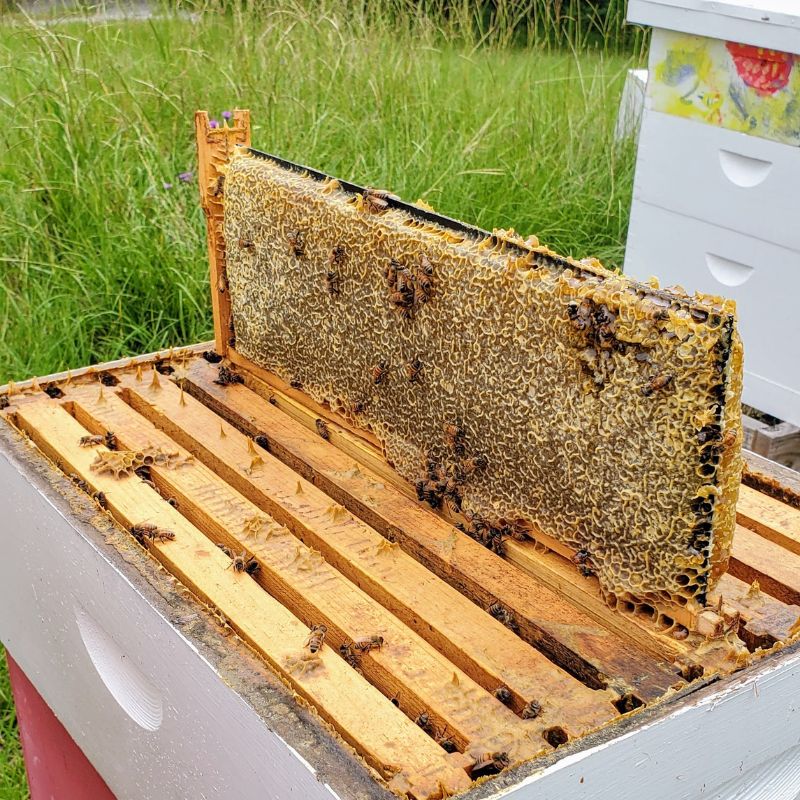
Beekeeping: A Rewarding Yet Challenging Endeavor


Beekeeping, the practice of managing bee colonies for the production of honey, beeswax, and other bee products, has gained immense popularity in recent years. While the allure of golden honey and the buzz around sustainability might entice aspiring beekeepers, it’s crucial to realistically assess the challenges and rewards that accompany this unique endeavor.
I. Introduction
Delving into the world of beekeeping, we uncover a captivating blend of nature’s wonders and the potential for financial rewards. However, it’s essential to approach beekeeping with a clear understanding of the demands and complexities involved. This outline explores the intricacies of beekeeping, examining the challenges and rewards that make this practice both demanding and fulfilling.
A. Defining Beekeeping
Beekeeping, also known as apiculture, encompasses the management of bee colonies, commonly referred to as hives. Beekeepers play a vital role in maintaining healthy bee populations, ensuring the pollination of essential crops, and providing a range of natural products with various health and commercial applications.
B. The Significance of Beekeeping
Bees are not only nature’s pollinators, but they also contribute significantly to the global economy. Studies have shown that the economic value of bee pollination far exceeds the direct value of bee products. Healthy bee populations are crucial for the production of fruits, vegetables, and oilseeds, ensuring food security and supporting agricultural livelihoods worldwide.
II. Unveiling the Challenges of Beekeeping
While the rewards of beekeeping can be substantial, the path to success is not without its challenges. Aspiring beekeepers must be prepared to face various obstacles, ranging from physical demands to intricate management techniques.
A. Physical Demands and Labor
Beekeeping is a labor-intensive activity that requires regular attention and care. Beekeepers must dedicate time to inspecting hives, managing bee health, harvesting honey, extracting wax, and processing other bee products. This hands-on approach demands physical stamina and a willingness to work outdoors in various weather conditions.
B. Learning Curve and Knowledge Acquisition
Successful beekeeping requires ongoing learning and a deep understanding of bee biology, hive management techniques, and disease prevention strategies. Aspiring beekeepers can benefit from taking beekeeping courses, joining beekeeping associations, and seeking mentorship from experienced beekeepers. This continuous learning process ensures that beekeepers can adapt to changing environmental conditions, emerging diseases, and evolving beekeeping practices.
C. Risk of Colony Loss
Bee colonies are susceptible to various threats, including weather extremes, disease outbreaks, and pesticide use. Beekeepers need to be prepared for the possibility of losing colonies, which can significantly impact their honey production and income. Managing these risks requires vigilance, proactive disease control measures, and a deep understanding of local environmental factors.
D. Regulations and Permits
Depending on your location, there might be regulations or permits required for beekeeping operations. It’s essential to research and comply with local regulations regarding hive placement, apiary size, and bee product sales. These regulations aim to protect public health, prevent the spread of diseases, and ensure sustainable beekeeping practices.
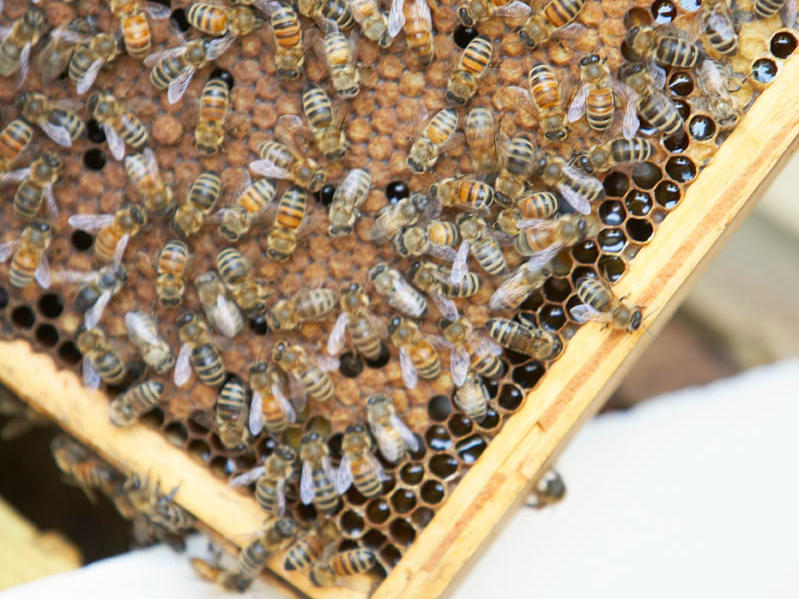
III. Embracing the Rewards of Beekeeping
Despite the challenges, beekeeping offers a unique set of rewards that make it a fulfilling and enriching endeavor.
A. Connection with Nature and Conservation
Beekeeping provides a deep connection with the natural world, fostering an appreciation for the intricate balance of ecosystems and the vital role of bees in maintaining biodiversity. Beekeepers play a crucial role in conservation efforts, contributing to the protection of bee populations and the health of our planet.
B. Personal Satisfaction and Learning
Beekeeping offers a sense of personal satisfaction and accomplishment as beekeepers witness the growth and productivity of their colonies. The process of caring for bees and harvesting their products provides hands-on learning opportunities, teaching valuable skills in observation, problem-solving, and adaptation.
C. Potential for Financial Gain
While beekeeping may not be a quick path to riches, it can potentially generate income for those who are dedicated and manage their operations effectively. Beekeepers can earn from the sale of honey, beeswax, pollen, propolis, and royal jelly. Additionally, some beekeepers offer pollination services to farmers, providing an additional revenue stream.
D. Community and Sharing of Knowledge
Beekeeping fosters a strong sense of community, connecting beekeepers with shared interests and a passion for these remarkable creatures. Beekeeping associations, workshops, and online forums provide platforms for knowledge sharing, collaboration, and mutual support.
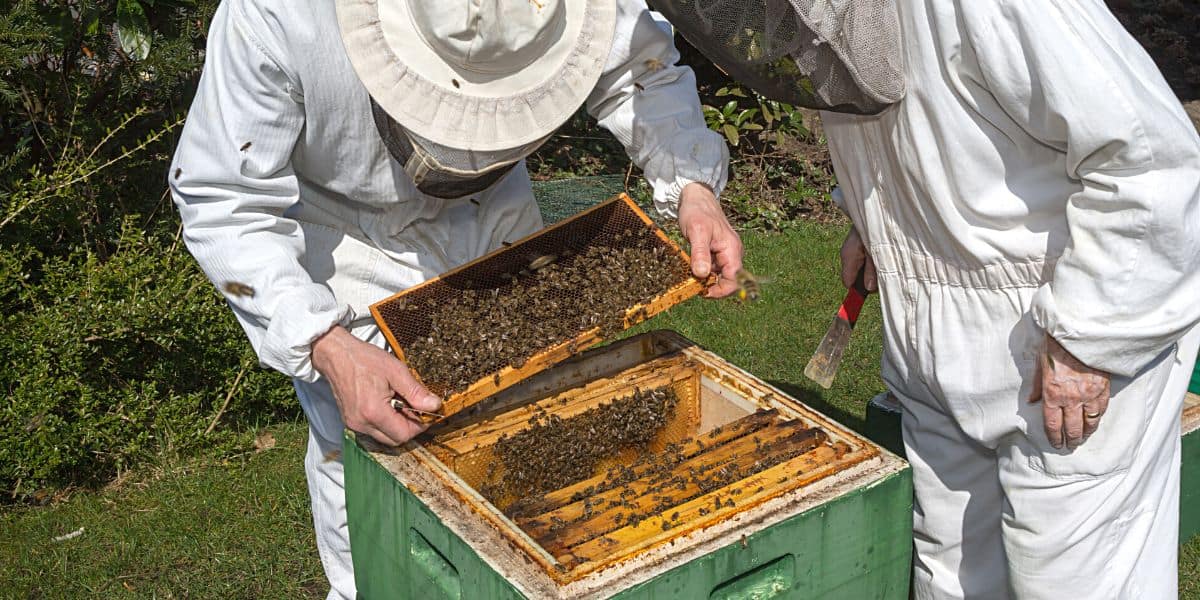
Is Beekeeping Right for You?
Before diving headfirst into beekeeping, it’s crucial to assess your personal motivations, resources, and commitment level. Here are some key questions to consider:
-
Are you passionate about bees and the environment? Beekeeping requires a genuine interest in these fascinating creatures and a desire to contribute to their well-being. Observing their complex social structures and the vital role they play in pollination can be a deeply rewarding experience.
-
Do you have the time and dedication to care for your hives? Beekeeping demands regular attention and cannot be treated as a passive investment. Regular inspections are necessary to monitor colony health, identify potential problems, and ensure optimal honey production.
-
Are you comfortable working with insects and potentially getting stung? While bee suits offer protection, stings are a part of beekeeping, and some individuals might have allergies that make it unsuitable for them. It’s essential to assess your tolerance for stings and potential allergic reactions before getting started.
-
Do you have the financial resources to cover the initial investment and ongoing expenses? Beekeeping requires an upfront investment in equipment, including hives, frames, bee suits, tools, and a vehicle for transporting hives. Additionally, there are ongoing costs for supplies like hive medication and honey extraction equipment.
-
Do you have access to a suitable location for your hives? Ideal locations offer access to diverse floral resources, have adequate sunlight, and are away from areas with high pesticide use. Additionally, local regulations might restrict hive placement within city limits, so research is crucial.
VI. Getting Started with Beekeeping
If you’ve weighed the challenges and remain enthusiastic about beekeeping, several resources can help you on your journey:
-
Beekeeping Associations: Joining your local beekeeping association connects you with experienced beekeepers who can offer guidance and support. These associations often organize workshops, demonstrations, and mentorship programs to equip beginners with the necessary skills.
-
Beekeeping Courses: Numerous online and in-person courses provide valuable knowledge on bee biology, hive management techniques, and honey production. These courses can be a great way to gain essential skills before starting your own apiary (bee yard).
-
Mentorship Programs: Connecting with a seasoned beekeeper for mentorship can provide invaluable hands-on learning and troubleshooting help. Observing experienced beekeepers manage their hives and tackle potential issues can offer significant practical knowledge.
-
Beekeeping Books and Online Resources: A wealth of information is available through beekeeping books, websites, and forums. These resources offer insights and advice from experienced beekeepers, covering various aspects of beekeeping, from hive management to honey extraction techniques.
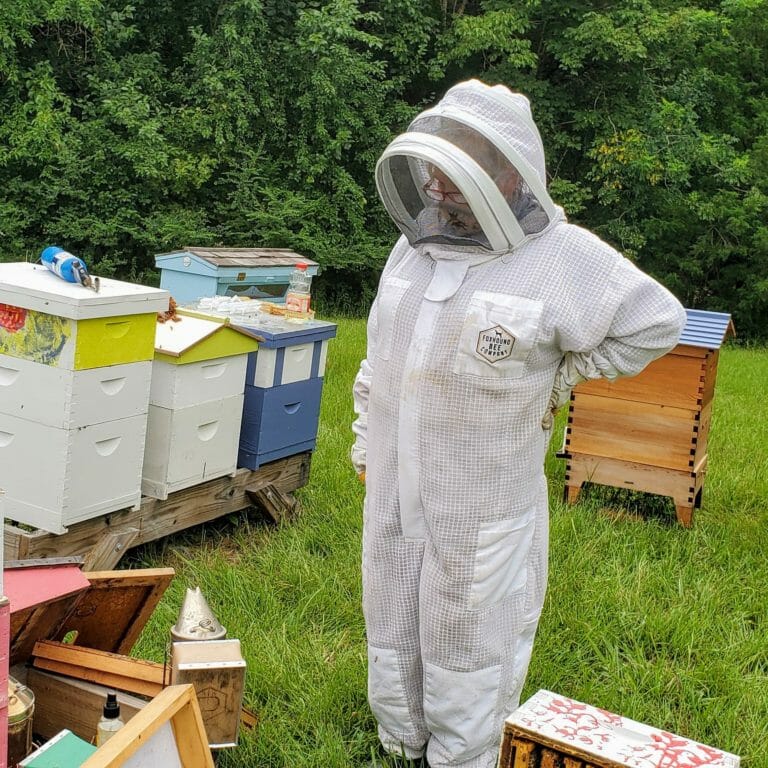
VII. Beekeeping Beyond Honey: Exploring Additional Products and Services
While honey is often the first product that comes to mind when considering beekeeping, these industrious insects offer a variety of other valuable products and services:
-
Beeswax: This natural wax has numerous applications, used in candles, cosmetics, and furniture polishes. Beekeepers can harvest beeswax from their hives and sell it to crafters or use it to create their own beeswax products.
-
Pollen: Packed with essential nutrients, bee pollen is becoming increasingly popular as a health supplement. Beekeepers can collect pollen using pollen traps placed on the entrance of the hive and sell it to health food stores or directly to consumers.
-
Propolis: This resinous substance produced by bees has potential antibacterial and antifungal properties. Beekeepers can harvest propolis from hives and sell it in tincture or capsule form, though regulations and licensing might be required depending on your location.
-
Royal Jelly: This milky secretion produced by worker bees is known for its purported health benefits. While the commercial market for royal jelly can be competitive, it can be another potential source of income for beekeepers with large operations.
-
Pollination Services: Beekeepers can lease their hives to farmers for pollination services, particularly in areas with high-value crops like almonds or berries. This can be a lucrative income stream, especially for beekeepers with a large number of healthy colonies.
Beekeeping goes beyond simply harvesting honey. By exploring these additional products and services, beekeepers can diversify their income streams and contribute significantly to sustainable agriculture.
IV. Conclusion
Beekeeping presents a unique opportunity to combine a passion for nature with the potential for personal fulfillment and financial rewards. However, it’s not a venture to be taken lightly. Success requires dedication, knowledge, and a willingness to face challenges. By carefully considering the factors mentioned above, aspiring beekeepers can make informed decisions
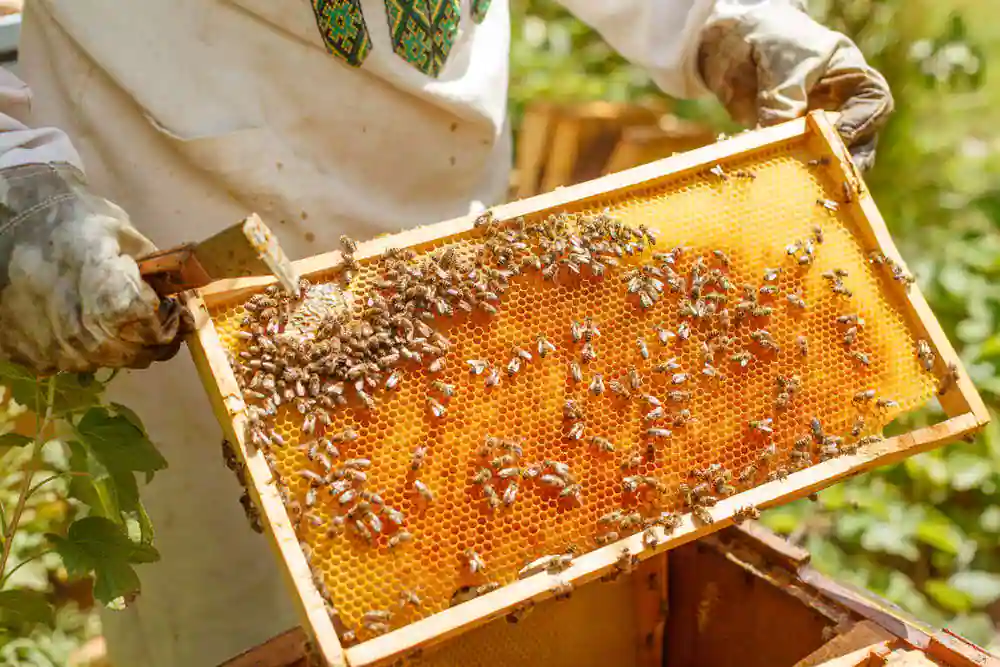
Beekeeping: A Profitable Endeavor or a Labor of Love?

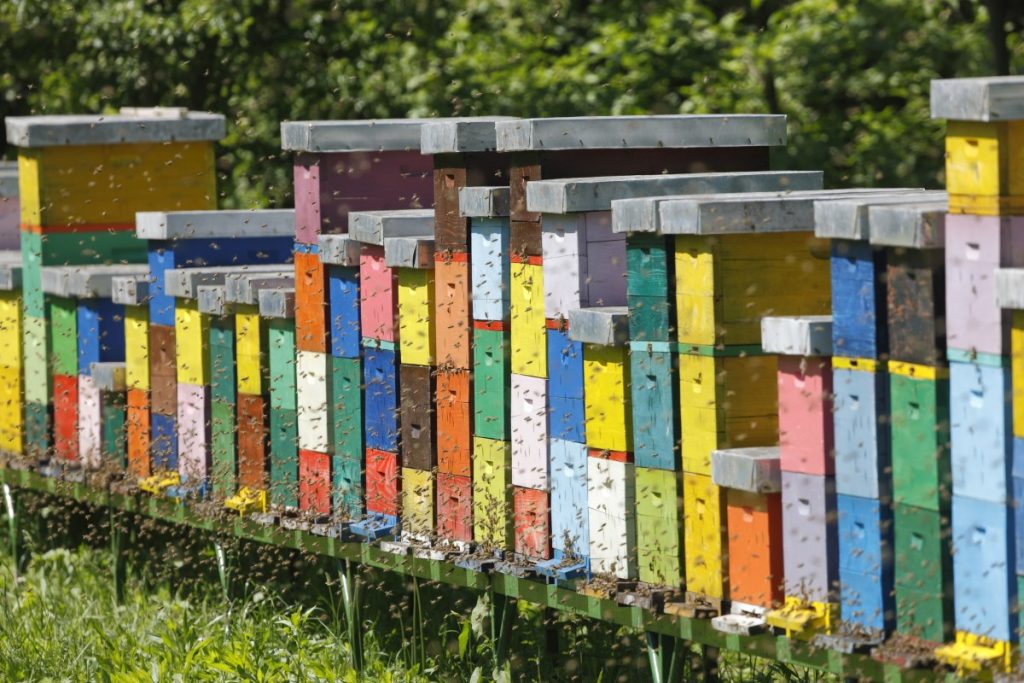
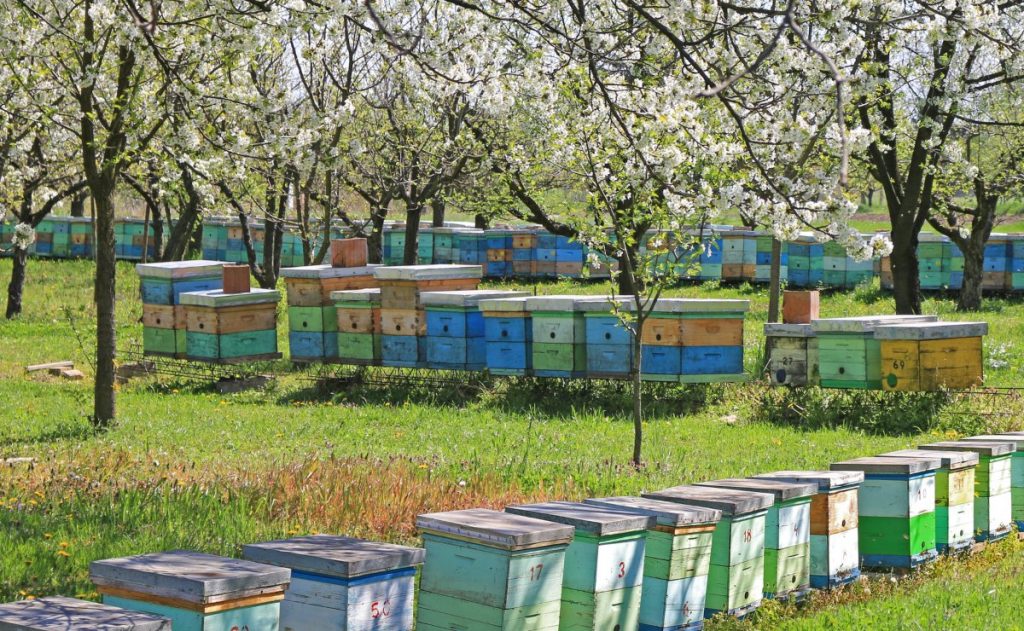

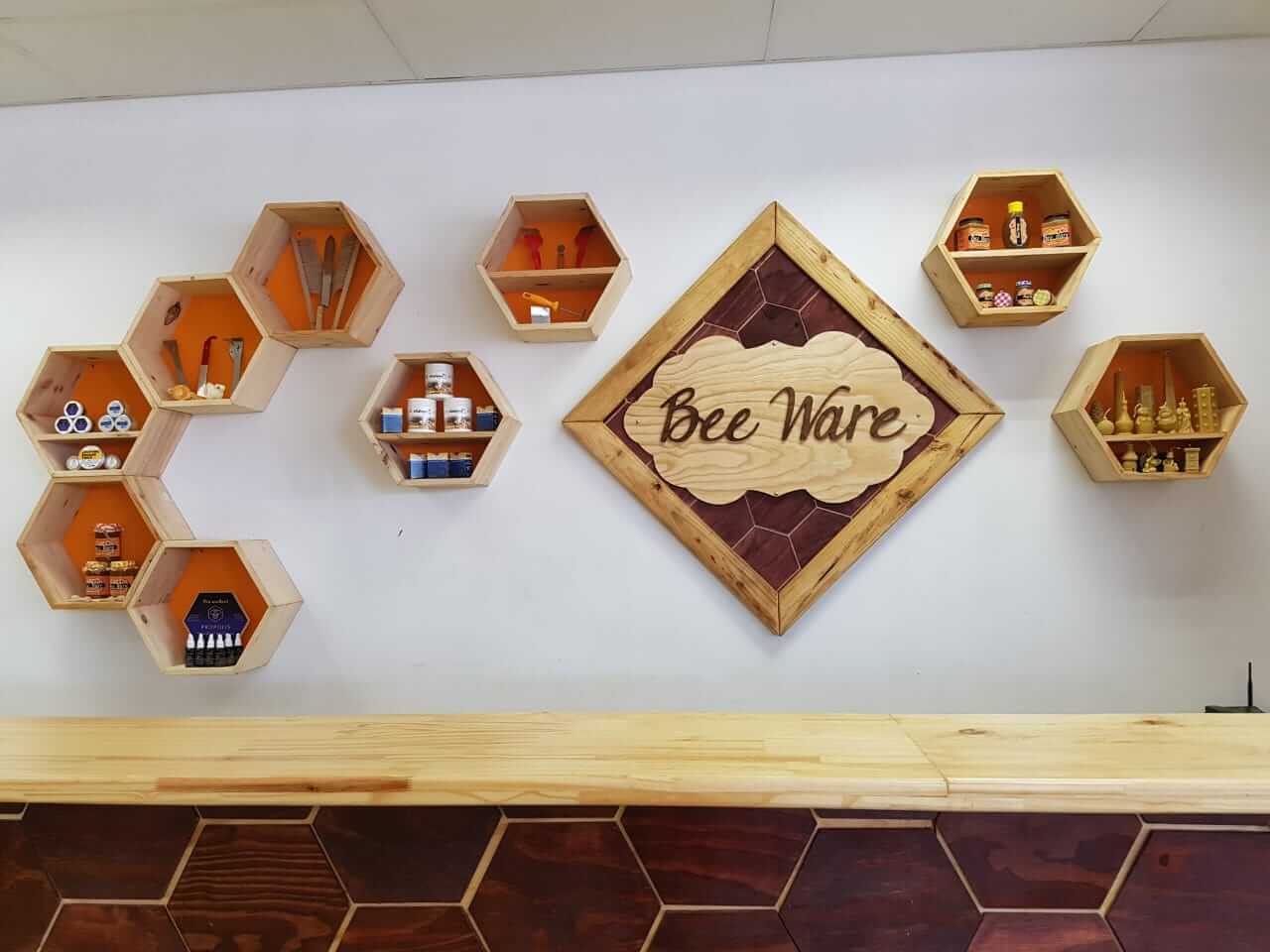
As the world grows increasingly conscious of the importance of sustainable practices and environmental stewardship, beekeeping has emerged not only as a fascinating hobby but also as a potentially profitable venture. These industrious insects, often referred to as nature’s tiny engineers, play a crucial role in our ecosystem by pollinating crops and ensuring the health of our planet’s flora. But is beekeeping truly a lucrative business, or is it more of a labor of love for those passionate about these remarkable creatures?
I. Introduction
Delving into the world of beekeeping, we uncover a captivating blend of nature’s wonders and the potential for financial rewards. While the allure of golden honey and other bee-derived products might entice aspiring beekeepers, it’s essential to realistically assess the profitability and challenges that accompany this unique enterprise.
A. Defining Beekeeping
Beekeeping, also known as apiculture, is the practice of managing bee colonies, commonly known as hives, for the production of honey, beeswax, pollen, propolis, and royal jelly. Beekeepers play a vital role in maintaining healthy bee populations, ensuring the pollination of essential crops, and providing a range of natural products with various health and commercial applications.
B. The Significance of Beekeeping
Bees are not only nature’s pollinators, but they also contribute significantly to the global economy. Studies have shown that the economic value of bee pollination far exceeds the direct value of bee products. Healthy bee populations are crucial for the production of fruits, vegetables, and oilseeds, ensuring food security and supporting agricultural livelihoods worldwide.
C. Growing Demand for Bee Products
The demand for bee products, particularly honey, has been steadily increasing in recent years. Consumers are drawn to the natural, health-promoting qualities of honey, seeking alternatives to processed sweeteners. This growing demand presents an opportunity for beekeepers to tap into a lucrative market.
II. Exploring the Profitability of Beekeeping
The profitability of beekeeping depends on various factors, including the size and location of the operation, the quality of beekeeping practices, market conditions, and the beekeeper’s own expertise and dedication.
A. Factors Influencing Beekeeping Profitability
-
Scale of Operation: Larger beekeeping operations, with hundreds or even thousands of hives, generally have the potential for higher profits. However, this requires significant investment in equipment, infrastructure, and labor.
-
Location and Floral Resources: The availability of diverse and abundant floral resources is essential for bee health and honey production. Beekeepers in regions with rich nectar sources are likely to experience higher yields.
-
Beekeeping Practices: Efficient beekeeping practices, including proper hive management, disease control, and pollination services, can significantly impact profitability.
-
Market Conditions: The price of honey and other bee products can fluctuate based on supply and demand. Beekeepers need to stay informed about market trends and adapt their strategies accordingly.
-
Beekeeper’s Expertise and Dedication: Successful beekeeping requires a deep understanding of bee biology, hive management, and market dynamics. Passionate and knowledgeable beekeepers are more likely to achieve profitability.
B. Average Profits in Beekeeping
Average profit margins in beekeeping vary widely depending on the factors mentioned above. Small-scale beekeepers, with a few dozen hives, may generate modest incomes, often supplementing their primary source of earnings. In contrast, large-scale commercial beekeepers can potentially achieve significant profits, especially if they can secure premium prices for their products or offer pollination services to agricultural operations.
C. Additional Income Streams for Beekeepers
Apart from honey and other bee products, beekeepers can explore additional income streams to enhance their profitability. These include:
-
Pollination Services: Beekeepers can lease their hives to farmers for pollination services, particularly in areas with high-value crops like almonds or berries.
-
Bee Products Workshops and Education: Beekeepers with expertise can offer workshops or educational programs to teach others about beekeeping practices and bee product utilization.
-
Bee-Related Tourism: Beekeepers can attract visitors to their apiaries for tours, honey tastings, or educational experiences, generating additional revenue.
III. Challenges and Considerations for Aspiring Beekeepers
While beekeeping can be a rewarding and potentially profitable venture, it’s crucial to acknowledge the challenges and considerations involved before embarking on this journey.
A. Initial Investment Costs
Establishing a beekeeping operation requires an initial investment in equipment, including hives, frames, bee suits, tools, and a vehicle for transporting hives. These upfront costs can be significant, especially for those starting on a larger scale.
-
Time Commitment and Labor (Continued): …extracting wax, and processing other bee products. Additionally, beekeepers need to stay updated on beekeeping practices and be prepared to address potential issues like hive diseases and pests.
-
Learning Curve and Knowledge Beekeeping requires ongoing learning and a deep understanding of bee biology, hive management techniques, and disease prevention strategies. Aspiring beekeepers can benefit from taking beekeeping courses, joining beekeeping associations, and seeking mentorship from experienced beekeepers.
-
Risk of Colony Loss Bee colonies are susceptible to various threats, including weather extremes, disease outbreaks, and pesticide use. Beekeepers need to be prepared for the possibility of losing colonies, which can significantly impact their honey production and income.
-
Regulations and Permits Depending on your location, there might be regulations or permits required for beekeeping operations. It’s essential to research and comply with local regulations regarding hive placement, apiary size, and bee product sales.
IV. Is Beekeeping Right for You?
Before diving headfirst into beekeeping, it’s crucial to assess your personal motivations, resources, and commitment level. Here are some key questions to consider:
-
Are you passionate about bees and the environment? Beekeeping requires a genuine interest in these fascinating creatures and a desire to contribute to their well-being.
-
Do you have the time and dedication to care for your hives? Beekeeping demands regular attention and cannot be treated as a passive investment.
-
Are you comfortable working with insects and potentially getting stung? While bee suits offer protection, stings are a part of beekeeping, and some individuals might have allergies that make it unsuitable for them.
-
Do you have the financial resources to cover the initial investment and ongoing expenses? Beekeeping requires an upfront investment and ongoing costs for equipment, supplies, and beehive maintenance.
-
Do you have access to a suitable location for your hives? Ideal locations offer access to diverse floral resources, have adequate sunlight, and are away from areas with high pesticide use.
V. Getting Started with Beekeeping
If you’ve weighed the challenges and remain enthusiastic about beekeeping, several resources can help you on your journey:
-
Beekeeping Associations: Joining your local beekeeping association connects you with experienced beekeepers who can offer guidance and support.
-
Beekeeping Courses: Numerous online and in-person courses provide valuable knowledge on bee biology, hive management, and honey production.
-
Mentorship Programs: Connecting with a seasoned beekeeper for mentorship can provide invaluable hands-on learning and troubleshooting help.
-
Beekeeping Books and Online Resources: A wealth of information is available through beekeeping books, websites, and forums, offering insights and advice from experienced beekeepers.
VI. Conclusion
Beekeeping presents a unique opportunity to combine a passion for nature with the potential for financial rewards. However, it’s not a get-rich-quick scheme. Success requires dedication, knowledge, and a willingness to face challenges. By carefully considering the factors mentioned above, aspiring beekeepers can make informed decisions and embark on a rewarding journey into the fascinating world of these essential pollinators. Remember, beekeeping can be a profitable endeavor, but more importantly, it’s a chance to contribute to the well-being of bees and the environment we all share.
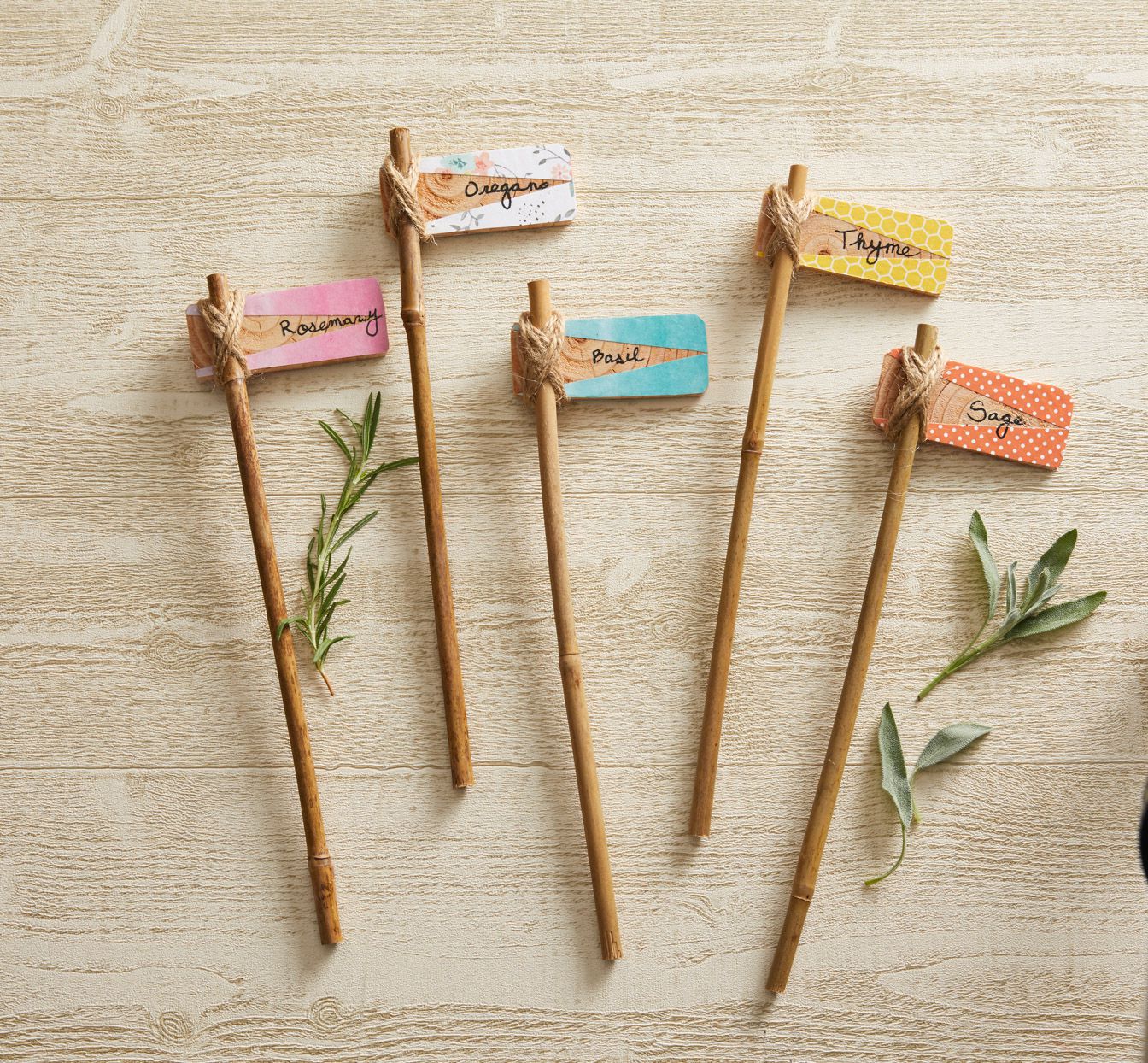
Keeping Tabs: The Best Plant Markers for Your Garden
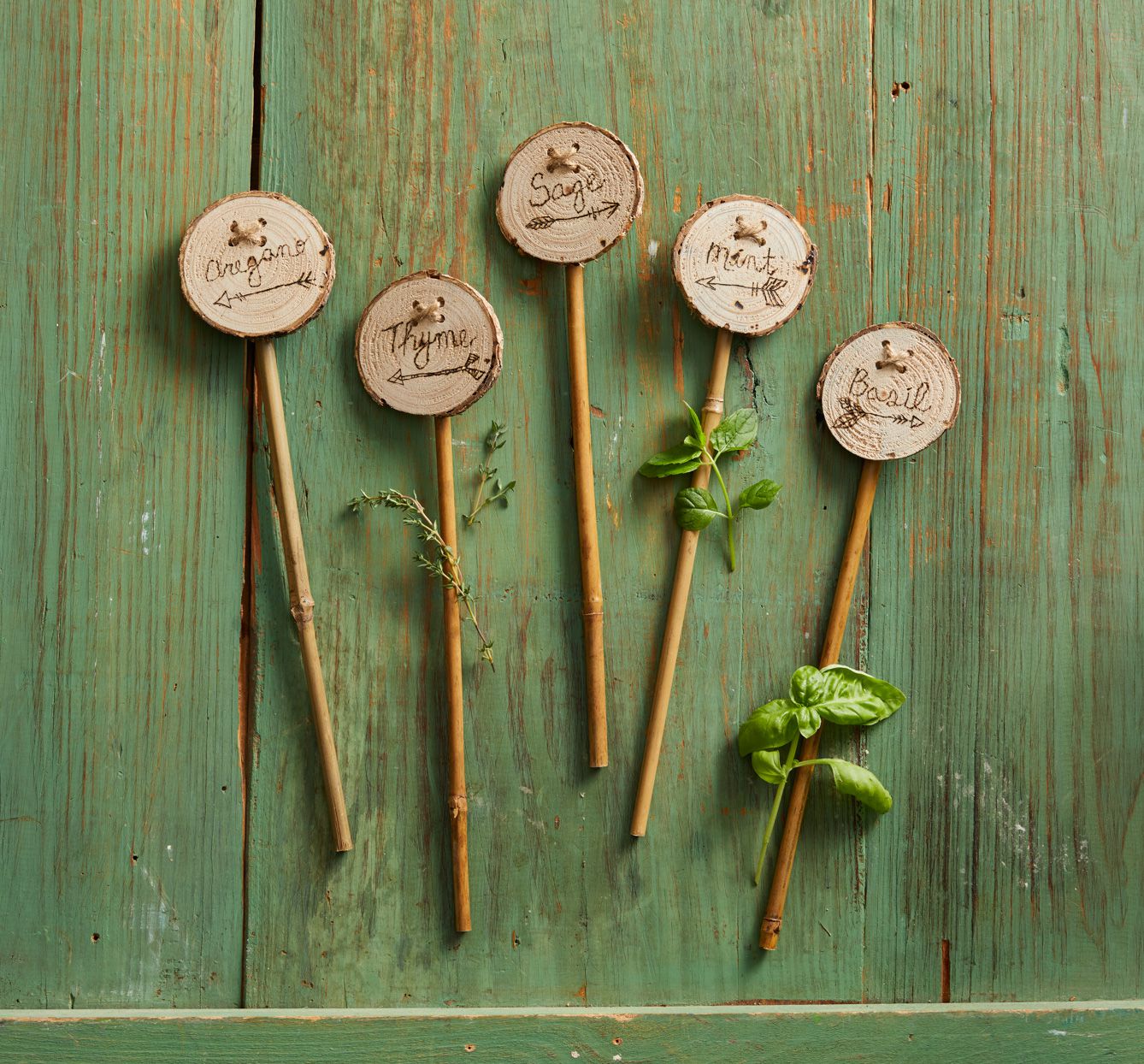


1. Introduction
A. Definition and purpose of plant markers
Plant markers are small tags or labels used to identify and provide information about individual plants in a garden, greenhouse, or nursery setting. They serve as a valuable tool for gardeners, horticulturists, and researchers, aiding in plant organization, record-keeping, and communication.
B. Significance of plant markers in gardening and horticulture
Plant markers play a crucial role in various aspects of gardening and horticulture:
-
Plant identification: Clearly labeling plants allows for easy identification of species, varieties, and cultivars, particularly in areas with diverse plantings or when dealing with a large number of plants.
-
Record-keeping and organization: Plant markers provide a convenient way to record and organize information about individual plants, including planting dates, care instructions, and any unique characteristics or observations.
-
Communication and sharing information: Plant markers facilitate communication among gardeners, horticulturists, and researchers, enabling the sharing of knowledge, experiences, and best practices.
C. Overview of the different types of plant markers
Plant markers come in a variety of forms, each with its own advantages and applications. The choice of marker depends on the specific needs and preferences of the user.
2. Classification of Plant Markers Based on Material
A. Plastic plant markers: Lightweight, durable, and affordable option
Plastic plant markers are a popular choice due to their lightweight, durable, and affordable nature. They are available in various shapes, sizes, and colors, making them versatile for a wide range of applications.
B. Wooden plant markers: Natural and aesthetically pleasing option
Wooden plant markers offer a natural and aesthetically pleasing alternative to plastic markers. They are often used in decorative gardens or for plants with a rustic or natural aesthetic.
C. Metal plant markers: Durable and resistant to harsh conditions
Metal plant markers are highly durable and resistant to harsh weather conditions, making them suitable for outdoor use in gardens or nurseries. They can be engraved or etched with permanent information.
D. Stone or ceramic plant markers: Elegant and long-lasting option
Stone or ceramic plant markers add an elegant and long-lasting touch to gardens. They are often used for labeling prized plants or creating a permanent record of plant information.
E. Biodegradable plant markers: Eco-friendly option for sustainable gardening
Biodegradable plant markers are made from environmentally friendly materials that break down naturally over time, reducing waste and promoting sustainability in gardening practices.
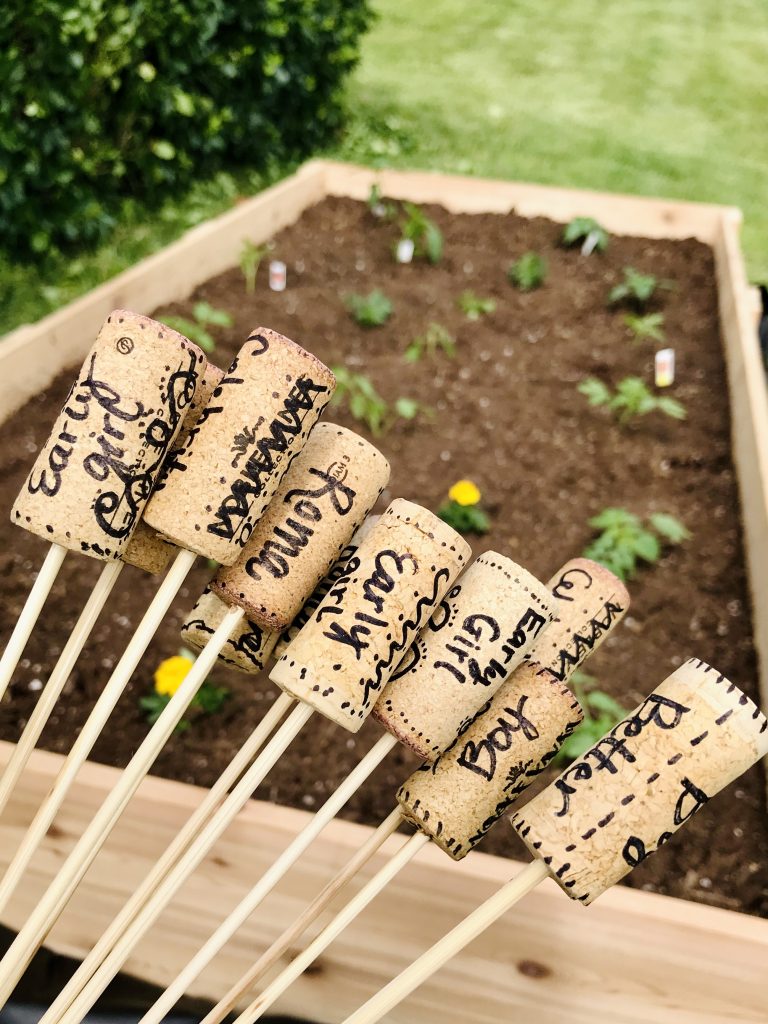
3. Classification of Plant Markers Based on Writing Surface
A. Blank plant markers: Customizable with permanent or temporary markers
Blank plant markers offer flexibility, allowing users to customize them with permanent or temporary markers. They are suitable for detailed information or temporary labeling.
B. Pre-printed plant markers: Printed with common plant names or labels
Pre-printed plant markers provide quick and easy identification of common plants. They are often used in nurseries or for basic labeling purposes.
C. Engraved or etched plant markers: Permanent and durable labeling
Engraved or etched plant markers offer permanent and durable labeling, particularly for metal or stone markers. They are ideal for labeling prized plants or creating a lasting record of plant information.
D. Write-on plant markers: Reusable and erasable for temporary labeling
Write-on plant markers have a writable surface that allows for temporary labeling. They are reusable and can be erased for re-use, making them suitable for tracking plant growth or identifying seedlings.
E. Digital plant markers: Utilizing QR codes or RFID tags for advanced information
Digital plant markers incorporate QR codes or RFID tags that link to online databases or store detailed plant information. They offer advanced tracking and data management capabilities.
4. Classification of Plant Markers Based on Style and Design
A. Traditional plant markers: Simple and functional labels
Traditional plant markers are simple and functional, typically consisting of a rectangular or oval shape with a labeled surface. They are widely used for basic plant identification and record-keeping.
B. Decorative plant markers: Adding a touch of style to gardens
Decorative plant markers add a touch of style and personality to gardens. They come in various shapes, designs, and colors, often incorporating natural elements or artistic motifs.
C. Humorous or whimsical plant markers: Adding a touch of fun to gardening
Humorous or whimsical plant markers inject a touch of fun and lightheartedness into gardening. They often feature playful phrases, puns, or quirky designs, adding a personal touch to plant labeling.
D. Themed plant markers: Coordinating with specific themes or styles
Themed plant markers can be coordinated with specific themes or styles, such as herb gardens, vegetable patches, or cottage gardens. They enhance the overall aesthetic of the garden and create a cohesive look.
E. Personalized plant markers: Adding a unique touch to plant labeling
Personalized plant markers allow for the addition of a unique touch to plant labeling. They can be customized with names, dates, or even small pictures, making them ideal for commemorating special occasions or highlighting specific plant characteristics.
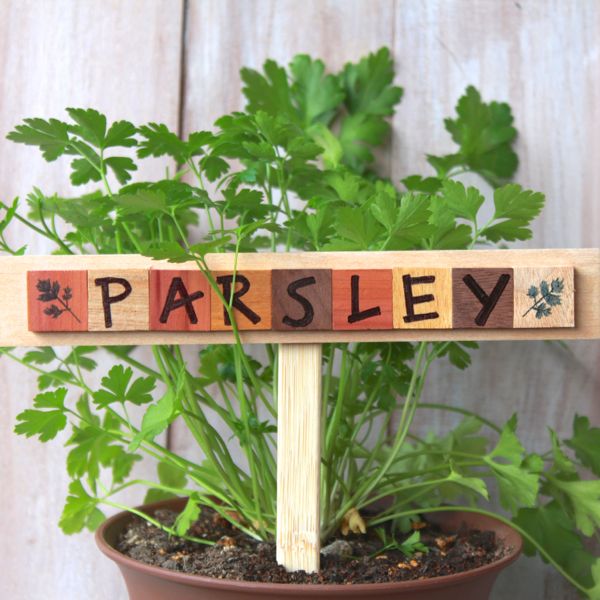
5. Choosing the Right Plant Marker
Selecting the right plant marker depends on several factors:
-
Durability: Consider the environmental conditions in your garden. Plastic or metal markers offer good durability for outdoor use, while wooden markers might be better suited for sheltered areas.
-
Usability: Decide how much information you want to display. Blank markers offer flexibility, while pre-printed markers provide quick identification for common plants.
-
Aesthetics: Consider the overall look of your garden. Traditional markers are functional, while decorative markers can add a personal touch.
-
Cost: Plant markers range in price depending on material and features. Plastic markers are generally affordable, while engraved metal or stone markers can be more expensive.
-
Sustainability: If eco-friendliness is a priority, opt for biodegradable markers made from recycled materials.
6. Tips for Using Plant Markers Effectively
-
Use a permanent marker: Ensure the writing on your plant marker will withstand the elements, especially for outdoor applications.
-
Write legibly: Clear and concise writing makes it easy to identify plants at a glance.
-
Include relevant information: Consider including details like plant name, variety, planting date, or specific care instructions.
-
Attach markers securely: Use a sturdy method to attach markers to plants, such as wires or plant clips, to prevent them from falling off or blowing away.
-
Maintain your markers: Over time, markers can become faded or damaged. Regularly check and replace them as needed.
7. Conclusion
Plant markers are a simple yet valuable tool for any gardener. They help keep your garden organized, provide essential information about your plants, and even add a touch of personality. By understanding the different types of plant markers available and considering your specific needs, you can choose the best option to enhance your gardening experience and ensure the success of your plants. As technology advances, we may even see the emergence of even more innovative plant markers, offering real-time data and insights into plant health and growth. So, the next time you’re planting a seed or transplanting a seedling, don’t forget the power of a humble plant marker!
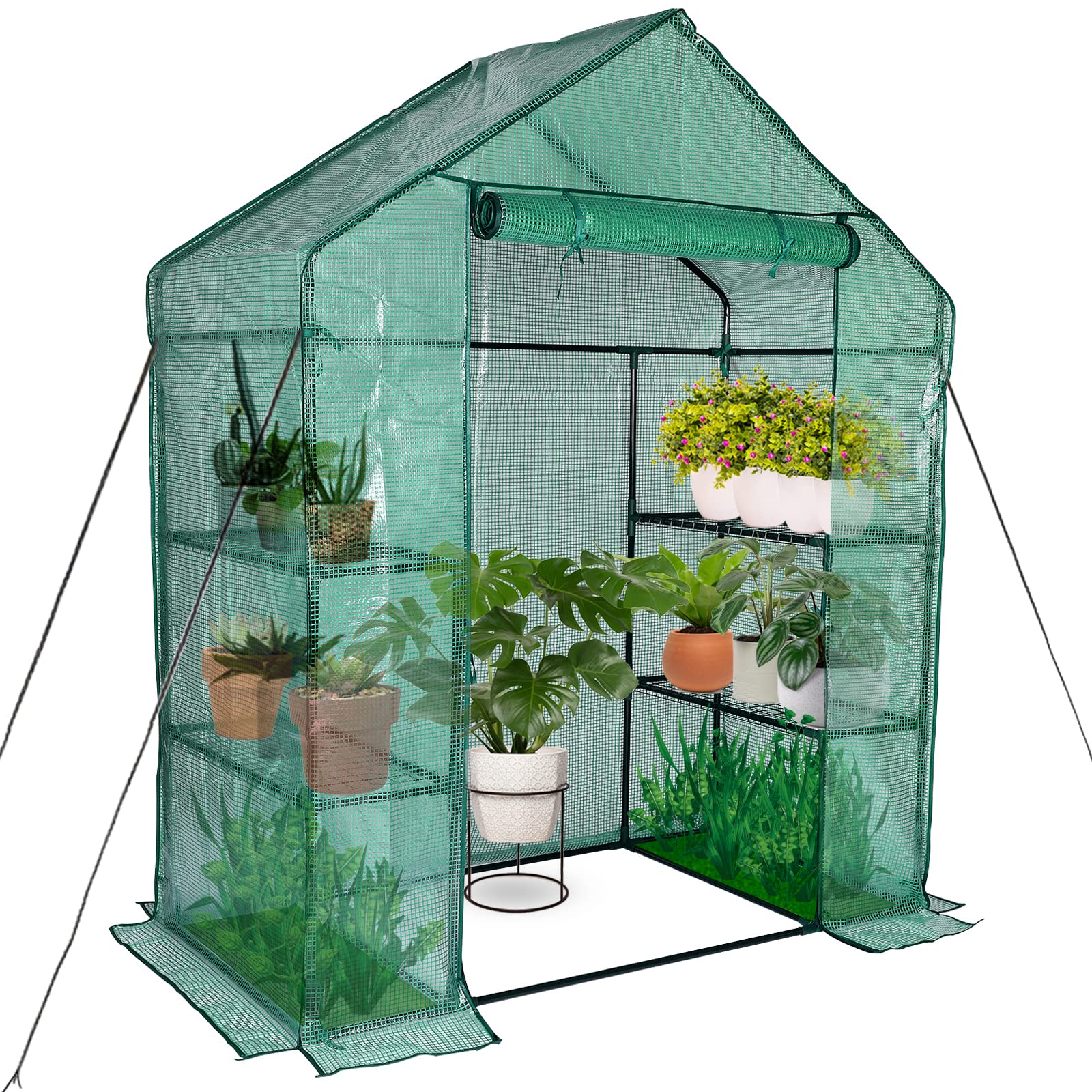
Types of Greenhouses


1. Introduction
A. Definition and purpose of greenhouses
Greenhouses are enclosed structures designed to create a controlled environment for plant growth. They provide shelter from harsh weather conditions, regulate temperature and humidity, and extend the growing season, enabling cultivation of a wider variety of crops throughout the year.
B. Significance of greenhouses in agriculture, horticulture, and research
Greenhouses play a crucial role in agriculture, horticulture, and research:
-
Agriculture: Greenhouses are essential for commercial crop production, particularly in regions with unfavorable climates or for out-of-season crops. They ensure consistent yields, protect crops from pests and diseases, and allow for intensive farming practices.
-
Horticulture: Greenhouses are widely used by hobbyists and home gardeners to grow their own fruits, vegetables, flowers, and herbs. They provide a controlled environment for nurturing seedlings, propagating plants, and extending the growing season.
-
Research: Greenhouses serve as controlled environments for scientific studies in plant biology, horticulture, agriculture, and environmental science. They allow researchers to manipulate environmental factors and observe plant responses under precise conditions.
C. Overview of the different types of greenhouses
Greenhouses come in a diverse range of types, each with its own unique characteristics and applications. The choice of greenhouse depends on various factors, including climate, crop type, budget, and available space.

2. Classification of Greenhouses Based on Structure
A. Lean-to greenhouses: Simple and economical designs attached to an existing structure
Lean-to greenhouses are constructed against an existing building, such as a house or garage, utilizing one side of the existing wall for support and cost savings. They are often used for small-scale home gardening or as extensions of living spaces.
B. Free-standing greenhouses: Versatile and customizable structures independent of existing buildings
Free-standing greenhouses are standalone structures that can be placed anywhere on a property. They offer greater flexibility in design, size, and placement, making them suitable for a wider range of applications.
C. Quonset-style greenhouses: Rounded arch design offering strength and snow load resistance
Quonset-style greenhouses feature a rounded arch design, resembling a half-cylinder. This shape provides superior strength and snow load resistance, making them ideal for areas with heavy snowfall or strong winds.
D. Even-span greenhouses: Simple rectangular structures with equal roof heights
Even-span greenhouses have a simple rectangular structure with equal roof heights. They are a popular choice for commercial growers due to their efficient use of space, ease of construction, and good light distribution.
E. Ridge-and-furrow greenhouses: Multiple parallel greenhouses connected by a central ridge
Ridge-and-furrow greenhouses consist of multiple parallel greenhouses connected by a central ridge. This design offers both the advantages of individual greenhouses and the efficiency of connected structures, making them suitable for large-scale commercial operations.

3. Classification of Greenhouses Based on Covering Material
A. Glass greenhouses: Traditional option offering excellent light transmission and insulation
Glass greenhouses have been the traditional choice for centuries, providing excellent light transmission and insulation properties. However, they can be more expensive and heavier than other materials.
B. Plastic greenhouses: Lightweight, durable, and affordable alternative to glass
Plastic greenhouses are a lightweight, durable, and affordable alternative to glass. They offer good light transmission and insulation, making them a popular choice for home gardeners and commercial growers.
C. Polycarbonate greenhouses: Combining the benefits of glass and plastic with high impact resistance and insulation
Polycarbonate greenhouses offer a combination of the benefits of glass and plastic. They are highly impact-resistant, provide excellent insulation, and transmit good light, making them a versatile option for various applications.
D. Fabric greenhouses: Lightweight and portable options for temporary or seasonal use
Fabric greenhouses are lightweight and portable, making them ideal for temporary or seasonal use. They are often used for starting seedlings, protecting crops from mild weather, or extending the growing season.
E. Double-glazed greenhouses: Enhanced insulation and temperature control for extreme climates
Double-glazed greenhouses feature two layers of glass or polycarbonate panels with an air gap in between. This provides enhanced insulation and temperature control, making them suitable for extreme climates or crops with specific temperature requirements.
4. Classification of Greenhouses Based on Ventilation
A. Natural ventilation: Utilizing vents, louvers, or open roofs for air circulation
Natural ventilation relies on vents, louvers, or open roofs to allow air circulation within the greenhouse. This method is simple and energy-efficient but may not be sufficient for precise temperature control or in areas with extreme weather conditions.
B. Forced ventilation: Employing fans or blowers to actively control airflow and temperature
Forced ventilation utilizes fans or blowers to actively control airflow and temperature within the greenhouse. This method provides more precise temperature control and is effective in areas with limited natural ventilation. However, it requires additional energy consumption to operate the fans or blowers.
C. Passive ventilation: Utilizing natural convection currents and chimney effects for air circulation
Passive ventilation utilizes natural convection currents and chimney effects to circulate air within the greenhouse. This method relies on temperature differences and strategically placed vents to create airflow. It’s a low-energy option but might not be as effective as forced ventilation for precise temperature control.
D. Evaporative cooling systems: Lowering greenhouse temperatures through water evaporation
Evaporative cooling systems use water evaporation to lower greenhouse temperatures. This method is particularly effective in hot, dry climates and can be combined with other ventilation methods for optimal climate control.
E. Hybrid ventilation systems: Combining natural and forced ventilation methods for optimal control
Hybrid ventilation systems combine natural and forced ventilation methods to achieve optimal temperature and humidity control. This approach offers flexibility and energy efficiency, utilizing natural ventilation when possible and relying on fans or blowers for additional control when needed.
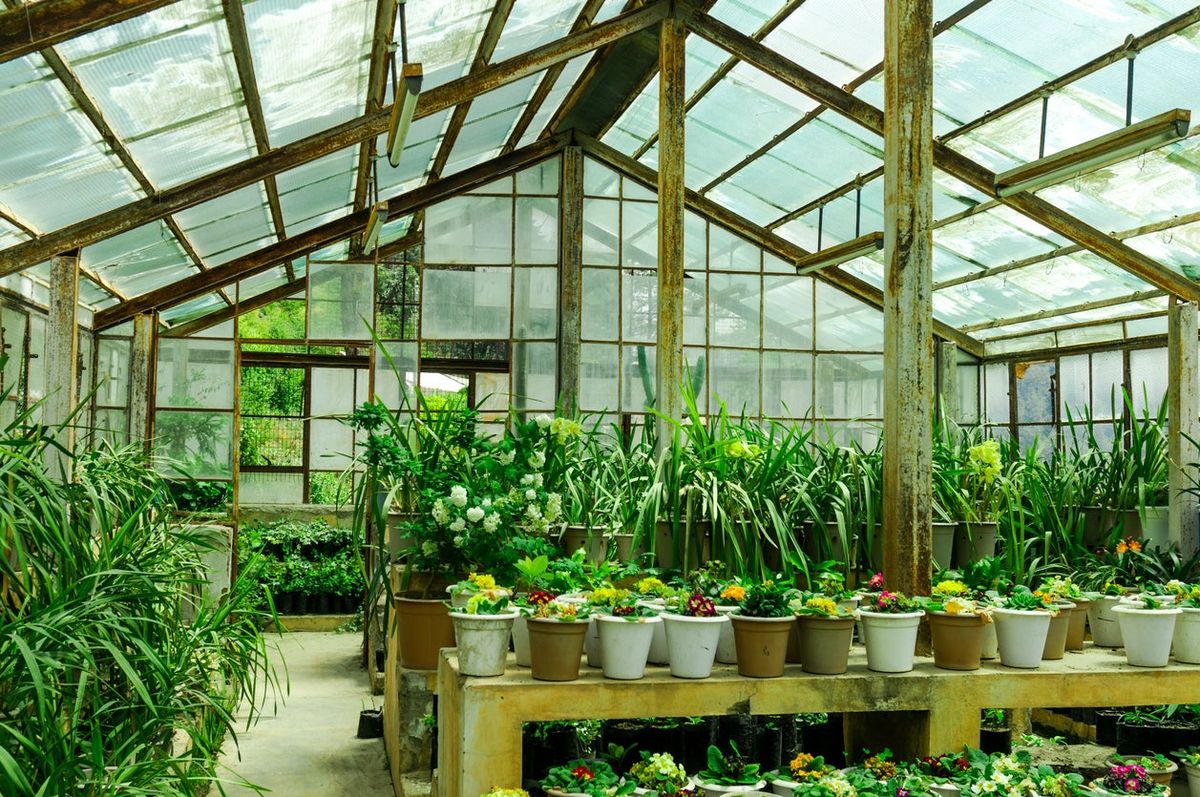
5. Classification of Greenhouses Based on Usage
A. Commercial greenhouses: Large-scale structures for commercial crop production
Commercial greenhouses are large-scale structures designed for high-volume production of fruits, vegetables, flowers, and other crops. They often utilize advanced technologies such as automated watering systems, climate control systems, and artificial lighting to optimize growth and yield.
B. Research greenhouses: Controlled environments for scientific studies and plant experiments
Research greenhouses are specifically designed to provide controlled environments for scientific studies and plant experiments. They often feature specialized equipment for manipulating temperature, humidity, light levels, and other environmental factors.
C. Hobby greenhouses: Smaller structures for home gardeners and enthusiasts
Hobby greenhouses are smaller structures used by home gardeners and enthusiasts to grow their own fruits, vegetables, flowers, or herbs. They offer a controlled environment for nurturing seedlings, propagating plants, and extending the growing season.
D. Educational greenhouses: Used for teaching horticulture and botany in schools and universities
Educational greenhouses serve as learning environments for students to learn about horticulture, botany, and plant science. They provide hands-on experience with plant growth and management, fostering appreciation for agriculture and sustainability.
E. Community greenhouses: Shared spaces for community gardening and food production
Community greenhouses are shared spaces where members of a community can come together to grow food. They promote social interaction, local food production, and sustainable growing practices.
6. Factors to Consider When Choosing a Greenhouse Type
Choosing the right greenhouse type depends on several factors:
-
Climate and weather conditions: Consider the local climate and weather patterns when selecting a greenhouse design. A strong structure may be necessary for areas with heavy snowfall or strong winds.
-
Crop type and growing requirements: Different crops have varying light, temperature, and humidity needs. Choose a greenhouse that provides the environment best suited for your desired plants.
-
Budget and available space: Greenhouses range in size and cost. Consider your budget and available space on your property when making your selection.
-
Ventilation and temperature control requirements: The level of ventilation and temperature control needed will depend on your climate and crop type. Choose a greenhouse with a suitable ventilation system.
-
Personal preferences and aesthetic considerations: Greenhouses are not just functional structures; they can also enhance your property’s aesthetics. Consider your personal preferences and choose a style that complements your landscaping.
7. Conclusion
Greenhouses offer a multitude of benefits for agriculture, horticulture, and research. By understanding the various types of greenhouses available, their characteristics, and their applications, you can choose the structure that best suits your specific needs and goals. Whether you are a commercial grower, a home gardener, or a researcher, greenhouses can provide the controlled environment needed to cultivate healthy, thriving plants. As advancements in greenhouse technology continue, we can expect even more innovative designs and functionalities, leading to a future of sustainable and efficient food production.
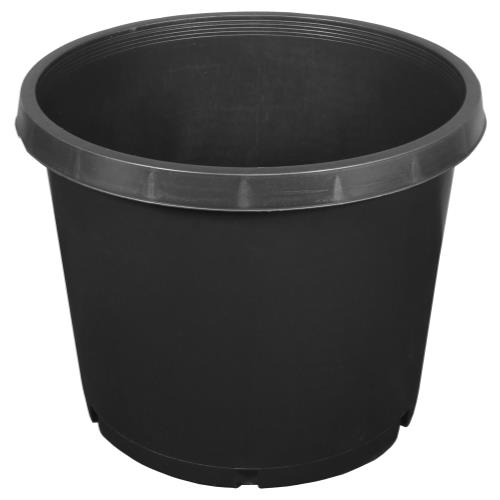
Nursery Pots: Cultivating Growth and Beauty
In the realm of gardening, few tools hold as much significance as the humble nursery pot. These unassuming containers play a pivotal role in nurturing young plants, providing them with a supportive environment to germinate, grow, and thrive. Whether you’re an experienced horticulturist or a budding enthusiast, understanding the intricacies of nursery pots is essential for cultivating a flourishing garden.
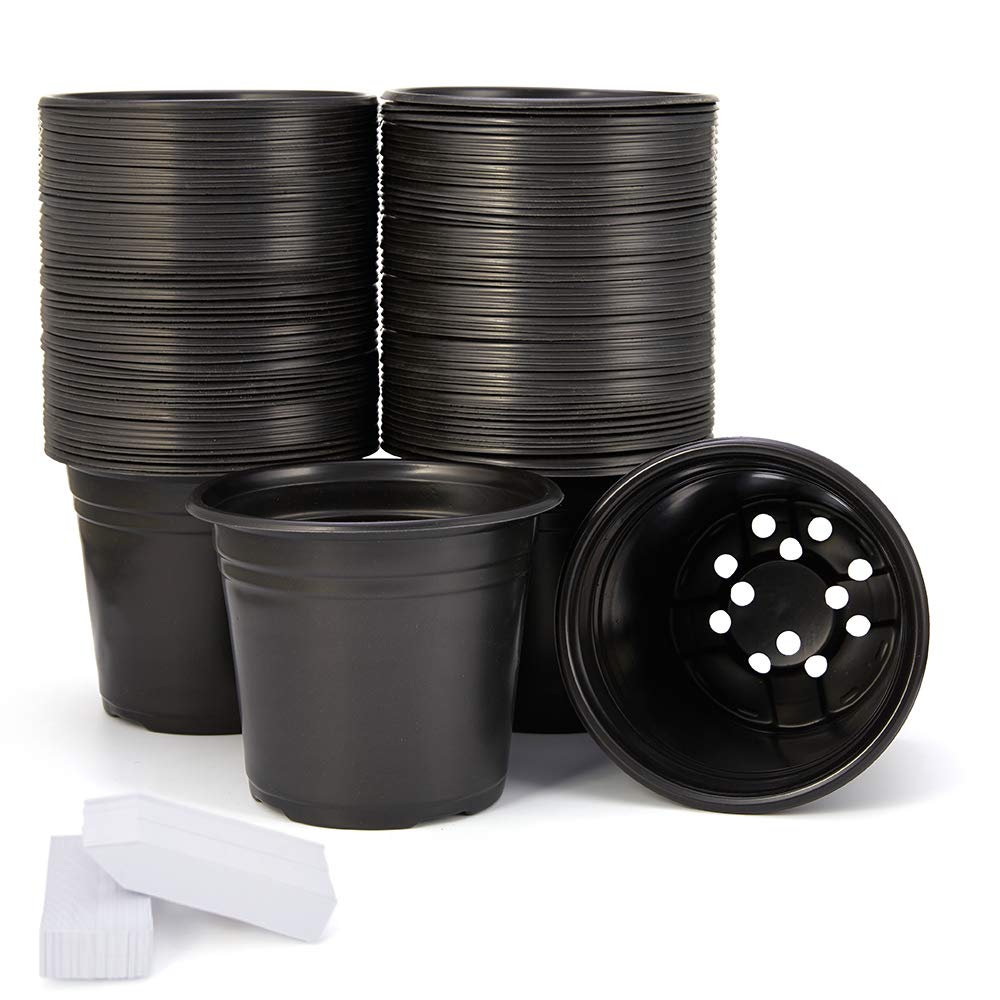
The Significance of Nursery Pots: Nurturing Young Plants
Nursery pots serve as a temporary home for plants during their initial stages of development. They offer several advantages that make them indispensable for gardeners:
-
Controlled Environment: Nursery pots provide a controlled environment, allowing you to tailor soil conditions, moisture levels, and exposure to light to suit the specific needs of each plant.
-
Protection from Pests and Diseases: By isolating young plants in nursery pots, you can minimize their exposure to soil-borne diseases, harmful insects, and harsh weather conditions.
-
Efficient Use of Space: Nursery pots allow you to organize and manage your seedlings or transplants efficiently, maximizing space utilization in your greenhouse or garden beds.
-
Portability: Nursery pots offer portability, enabling you to easily move plants around your garden or relocation them indoors for protection during extreme weather.
Types of Nursery Pots: A Diverse Range for Diverse Needs
Nursery pots come in a wide variety of shapes, sizes, and materials to accommodate the diverse needs of different plants and growing environments. Here are some of the most common types:
-
Plastic Nursery Pots: Lightweight, durable, and affordable, plastic nursery pots are a popular choice for both home gardeners and commercial nurseries.
-
Clay Nursery Pots: Clay pots offer excellent breathability and promote healthy root development. They are particularly well-suited for plants that prefer drier conditions.
-
Compostable Nursery Pots: Made from biodegradable materials such as paper or peat moss, compostable nursery pots are an eco-friendly option that breaks down naturally, reducing waste.
-
Seedling Trays: Divided into individual compartments, seedling trays are ideal for starting multiple seeds simultaneously, providing a controlled environment for germination.
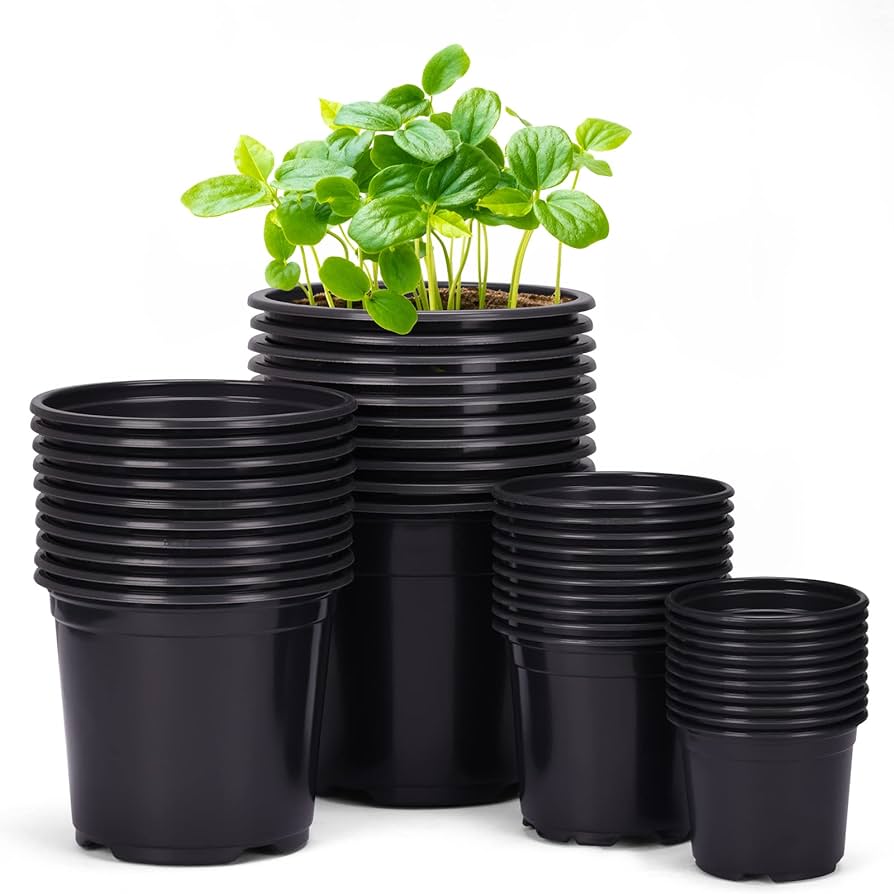
Material Choices for Nursery Pots: Durability, Sustainability, and Aesthetics
The material of your nursery pot choice can influence plant growth, sustainability, and the overall aesthetic of your garden. Consider the following factors when making your selection:
-
Durability: Choose a material that can withstand regular handling, watering, and exposure to the elements. Plastic and clay pots are generally durable options.
-
Sustainability: If eco-friendliness is a priority, consider compostable nursery pots made from biodegradable materials.
-
Aesthetics: Nursery pots can add a decorative touch to your garden. Choose materials and colors that complement your landscaping style.
Selecting the Right Nursery Pot: Size, Drainage, and Other Considerations
When selecting nursery pots, consider the size of your plant, its growth rate, and the duration it will spend in the pot. Ensure the pot is large enough to accommodate the plant’s root system without restricting growth. Adequate drainage holes are essential to prevent waterlogging and root rot.
For seedlings and young plants, smaller nursery pots are sufficient. As the plant matures, you’ll need to repot it into larger containers to provide ample space for root growth. Consider the material of the pot in relation to the plant’s needs. For instance, clay pots are well-suited for plants that prefer drier conditions, while plastic pots retain moisture better.
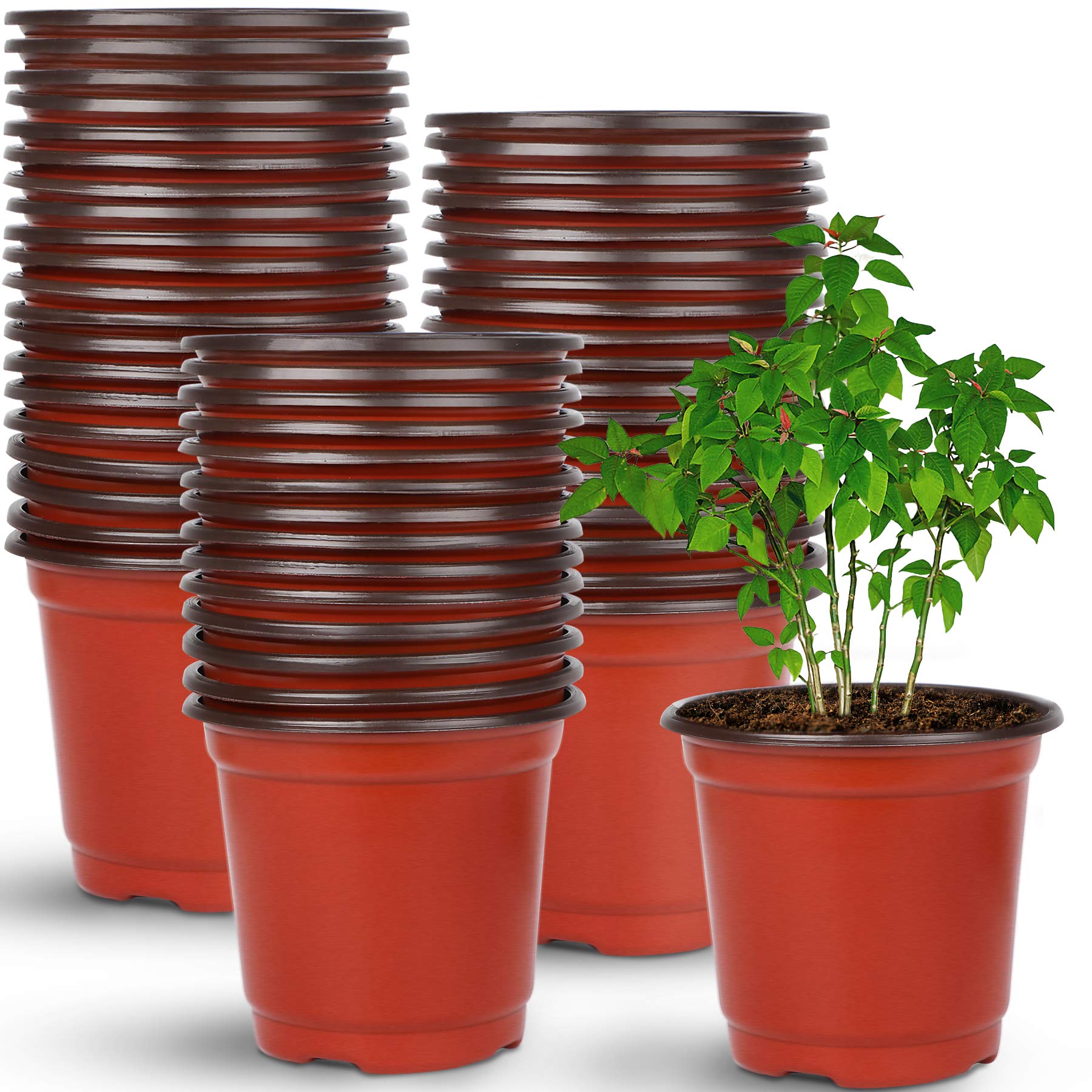
Filling the Nursery Pot: Creating an Optimal Growing Medium
The growing medium you choose plays a crucial role in plant health and growth. Select a well-draining potting mix that is appropriate for the type of plant you are growing. Consider adding organic matter, such as compost or aged manure, to improve soil structure and nutrient content.
Avoid overfilling the nursery pot, leaving a few inches of space at the top for watering and to prevent soil from spilling out. Gently firm the potting mix around the plant’s roots without compacting it too much.
Planting Techniques for Nursery Pots: Ensuring Successful Seed Germination or Transplanting
Whether you’re starting seeds or transplanting seedlings, proper planting techniques are essential for successful plant growth. For seeds, follow the recommended planting depth for each species. Gently press the seeds into the potting mix and cover them lightly with soil.
For transplanting seedlings, carefully remove the plant from its current container, ensuring the root ball remains intact. Dig a hole in the nursery pot slightly larger than the root ball, place the seedling in the hole, and gently fill the space with potting mix. Firm the soil around the base of the plant to provide support.
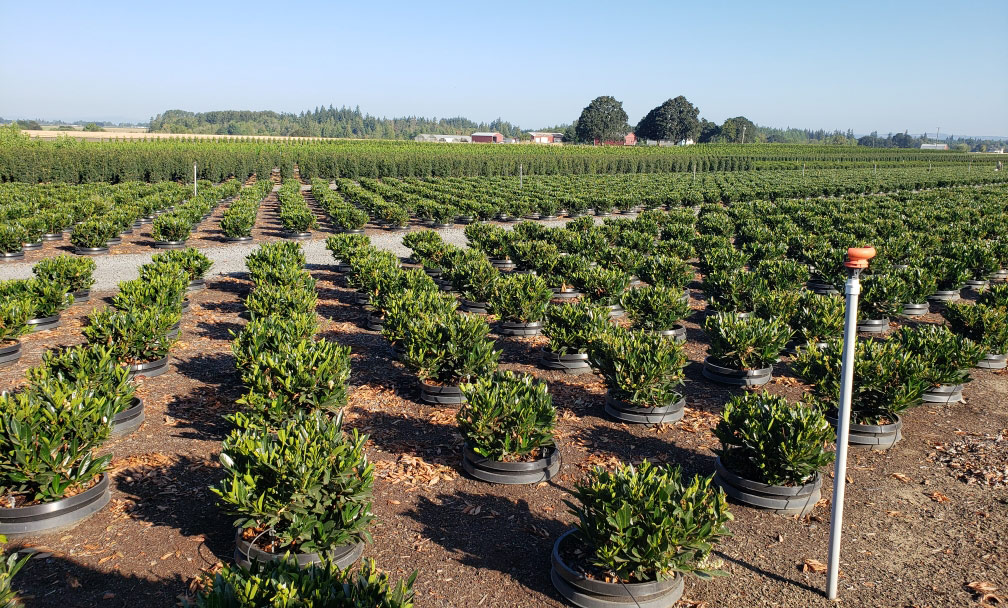
Watering and Drainage: Balancing Moisture Needs and Preventing Root Rot
Watering is crucial for plant growth, but overwatering can lead to root rot and other problems. Allow the top inch of soil to dry out slightly between waterings. When watering, ensure the pot drains thoroughly to prevent waterlogging.
The specific watering frequency will depend on the type of plant, the size of the pot, and the environmental conditions. Plants with high water needs will require more frequent watering than drought-tolerant varieties. Clay pots dry out faster than plastic pots, so you may need to adjust your watering schedule accordingly.
Monitoring Nursery Pot Plants: Recognizing Signs of Health and Stress
Keeping a close eye on your nursery pot plants allows you to identify potential problems early on. Look for signs of healthy growth, such as new leaves, vibrant green foliage, and firm stems. Conversely, wilting leaves, stunted growth, and yellowing foliage can indicate stress or potential issues.
Common causes of stress in nursery pot plants include overwatering, underwatering, lack of nutrients, insufficient light, or pest infestation. By identifying the signs of stress and addressing the underlying cause promptly, you can help your plants recover and thrive.
Repotting: Providing Adequate Space for Root Growth and Plant Development
As your plants grow, their root systems will expand. When the roots become pot-bound, it’s time to repot into a larger container. Signs of a root-bound plant include slow growth, leaves turning yellow or brown, and roots circling around the bottom of the pot.
Choose a new nursery pot that is 2-3 inches larger in diameter than the current pot. Gently remove the plant from its current container, loosening the root ball slightly if necessary. Repot the plant in the new container, backfill with fresh potting mix, and water thoroughly.

Conclusion
Nursery pots are a versatile and essential tool for gardeners of all levels. By understanding the different types of nursery pots available, selecting the right material and size, and providing proper care for your plants, you can cultivate healthy and thriving seedlings and transplants that will flourish in your garden. With a little knowledge and dedication, your nursery pots can become the foundation for a vibrant and flourishing green haven.
Additional Resources:
-
National Gardening Association: https://garden.org/ This website offers a wealth of information on gardening techniques, including tips on using nursery pots.
-
The Old Farmer’s Almanac: https://www.almanac.com/ This website provides helpful guides on choosing the right nursery pots for different plants and proper transplanting techniques.
-
Your local nursery or garden center: The staff at your local nursery or garden center can offer valuable advice on selecting the right nursery pots for your specific needs and plants.
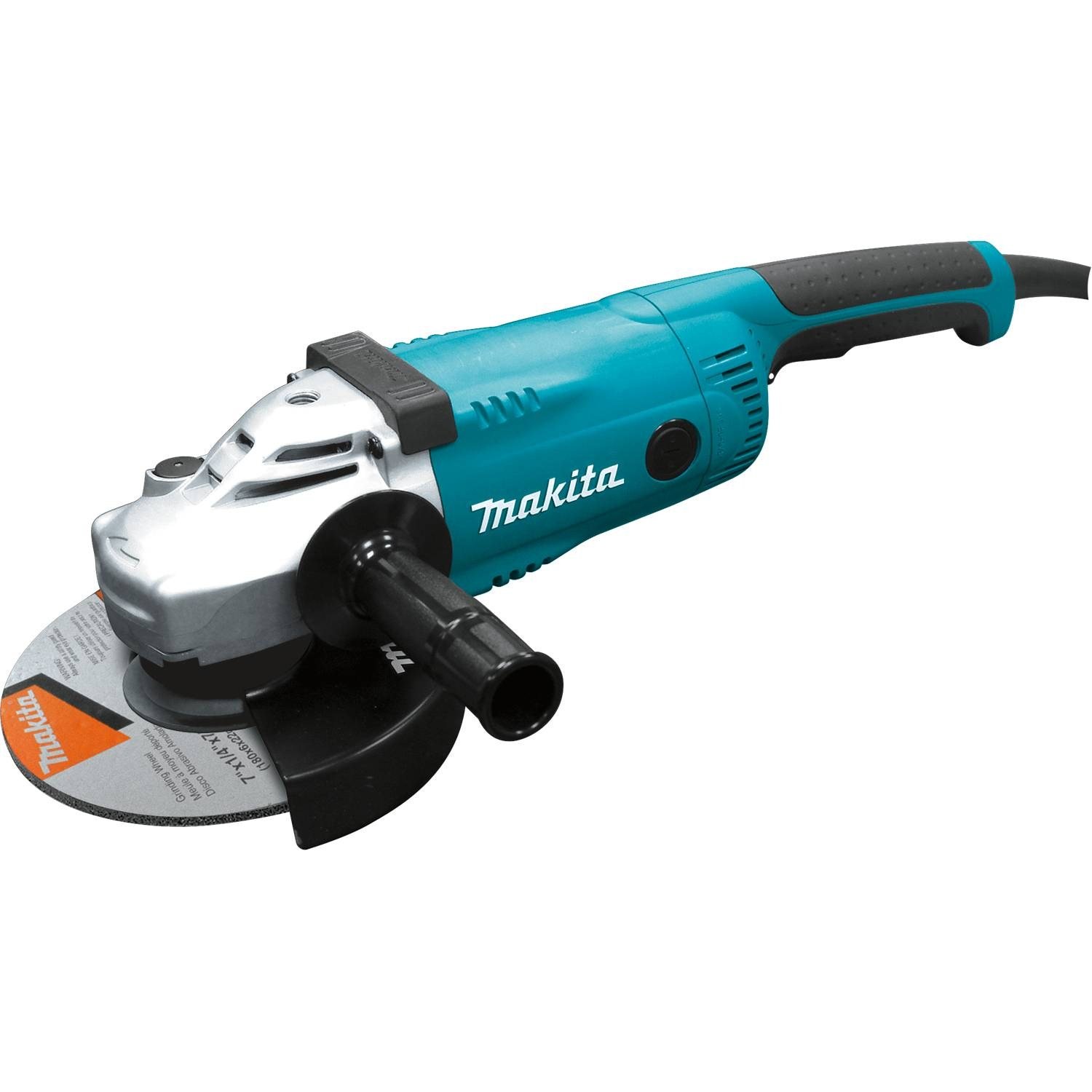
Makita Angle Grinders: Power, Precision, and Performance
In the realm of power tools, few names hold as much renown as Makita. Renowned for their durability, performance, and innovation, Makita tools have become the go-to choice for professionals and DIY enthusiasts alike. Among their extensive range of power tools, Makita angle grinders stand out as a testament to the brand’s commitment to excellence.

A Legacy of Craftsmanship: The History of Makita Angle Grinders
The story of Makita angle grinders began in 1919 when Masatoshi Makita founded Makita Works Ltd. in Japan. Initially focused on repairing and manufacturing electric motors, Makita quickly established a reputation for quality and reliability. In 1958, the company introduced its first portable hand-held power tool, a portable electric planer, marking a pivotal moment in Makita’s history.
The development of Makita angle grinders followed soon after, with the introduction of the first model in 1964. This groundbreaking tool revolutionized the way materials were cut, ground, and polished, quickly gaining popularity among construction workers, metalworkers, and hobbyists. Since then, Makita has continuously refined and innovated its angle grinder line, introducing new models with enhanced features and capabilities.
Types of Makita Angle Grinders: Catering to Diverse Needs
Makita angle grinders come in a variety of types to suit the specific needs of users. The most common classification is based on wheel size, ranging from compact 4-inch models to powerful 9-inch grinders. Each wheel size offers unique advantages, with smaller wheels providing maneuverability and larger wheels delivering greater cutting depth and power.
Another crucial distinction is between corded and cordless angle grinders. Corded models offer unlimited runtime, ideal for continuous use in workshops or construction sites. Cordless grinders, on the other hand, provide portability and convenience, making them suitable for on-the-go applications or areas with limited power access.
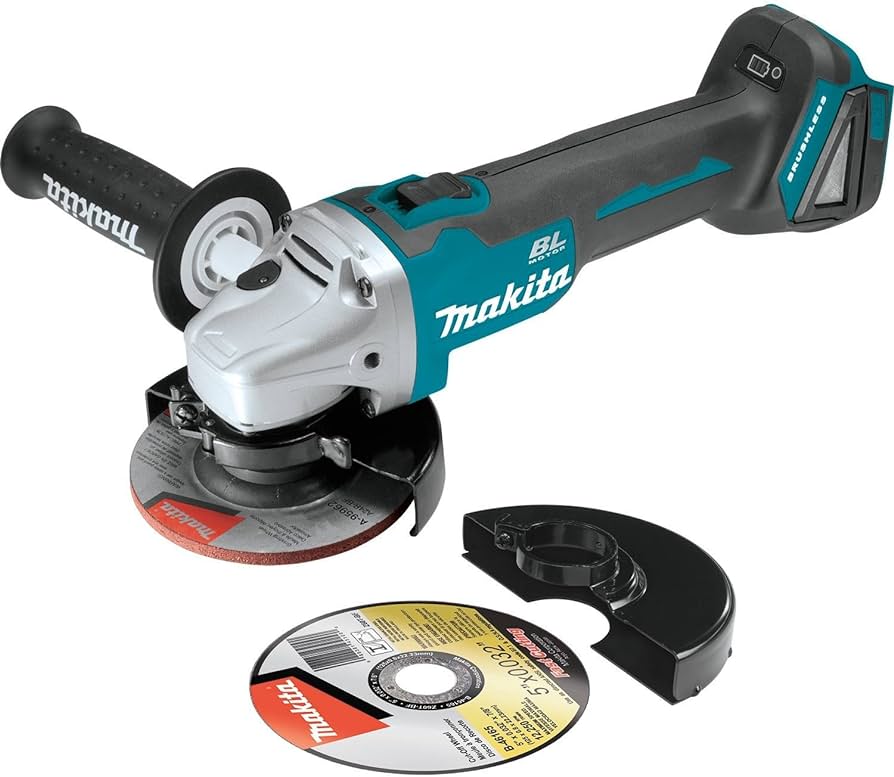
Unveiling the Powerhouse: Key Features and Benefits of Makita Angle Grinders
Makita angle grinders are renowned for their exceptional features and benefits, making them a favorite among professionals and enthusiasts alike. At the heart of their performance lies powerful motors that deliver high torque and speed, enabling users to tackle even the most demanding tasks with ease.
Durability is another hallmark of Makita angle grinders. These tools are built to withstand harsh working conditions and heavy-duty use, thanks to robust construction and high-quality materials. This durability extends to the ergonomic design, which minimizes fatigue and maximizes operator comfort, even during prolonged use.
Safety remains a top priority for Makita, and their angle grinders are equipped with advanced safety features to protect users from potential hazards. These features include protective guards to prevent accidental contact with grinding wheels, safety switches to prevent accidental starts, and vibration dampening systems to reduce fatigue.
Versatility is another key strength of Makita angle grinders. These versatile tools can handle a wide range of tasks, from grinding and cutting metal to polishing stone and tile. Their adaptability makes them indispensable in various industries, including construction, manufacturing, automotive, and home improvement.
Applications: Unleashing the Versatility of Makita Angle Grinders
Makita angle grinders are not just powerful tools; they are also incredibly versatile, capable of handling a diverse range of applications. In the metalworking industry, these grinders are used for grinding, cutting, and polishing metal surfaces, shaping and finishing metal components, and preparing surfaces for welding.
Construction workers rely on Makita angle grinders for cutting rebar, concrete, and other construction materials, while fabricators use them for shaping and finishing metal components. Stonework applications include grinding, cutting, and polishing stone and tile, while automotive enthusiasts utilize these grinders for grinding and polishing car bodies and components.
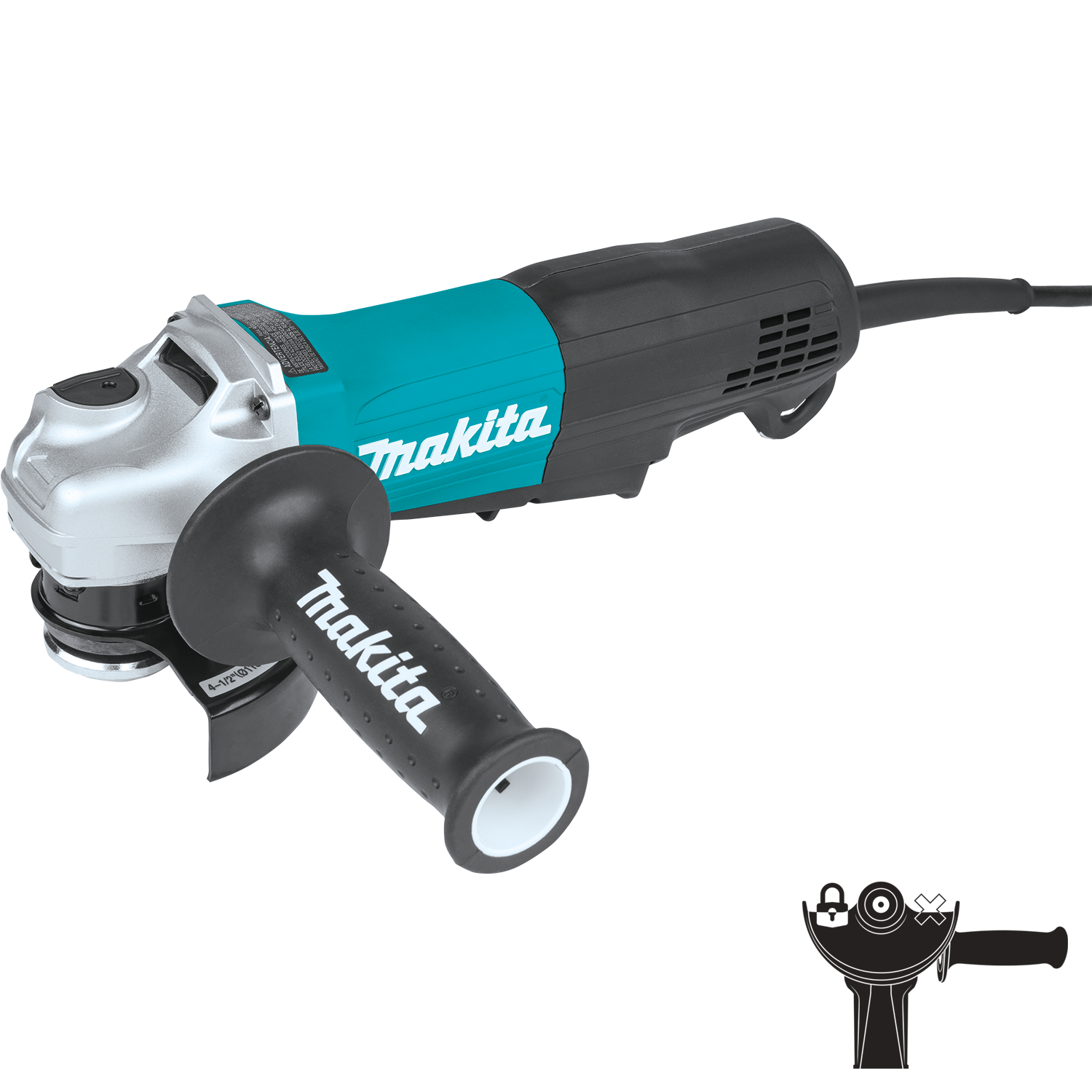
Safety First: Essential Guidelines for Using Makita Angle Grinders
When operating any power tool, safety should be paramount. Makita angle grinders, with their powerful motors and rotating wheels, demand particular attention to safety precautions. Proper personal protective equipment (PPE) is essential, including safety glasses, gloves, hearing protection, and respiratory protection to shield oneself from dust, sparks, and noise.
Before each use, it’s crucial to inspect the angle grinder for any damage, loose components, or improper wheel installation. Ensuring the workpiece is firmly secured to prevent kickback is paramount. Proper grinding technique involves maintaining a stable grip, using the correct cutting angle, and avoiding excessive force.
After each use, thorough cleaning and inspection are essential to maintain the grinder’s performance and longevity. Regular maintenance includes sharpening or replacing grinding wheels, lubricating moving parts according to manufacturer’s instructions, and proper care of the electrical cord or battery (for cordless models).
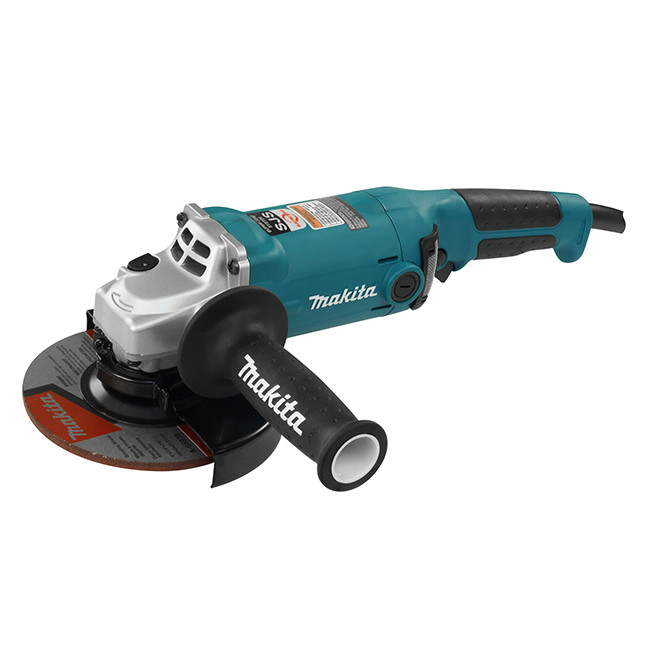
Maintenance and Care: Extending the Lifespan of Makita Angle Grinders
Regular maintenance and care are crucial for extending the lifespan of your Makita angle grinder and ensuring optimal performance. The first line of defense is regular cleaning and inspection. Removing dust, debris, and any signs of damage, such as cracks or worn components, should be a routine practice.
Sharpening or replacing grinding wheels is equally important. A blunt wheel not only reduces efficiency but can also be a safety hazard. When replacing the wheel, ensure it’s compatible with your grinder’s size and speed rating. Following the manufacturer’s instructions for lubrication of moving parts is vital to maintain smooth operation and prevent premature wear.
For corded models, proper care of the electrical cord is essential. Regularly checking for signs of wear and tear, avoiding excessive bending, and using proper extension cords with adequate gauge will prevent electrical issues. Cordless models require proper battery care for optimal performance and longevity. Following the manufacturer’s recommendations for charging, storage, and disposal of batteries will ensure their continued functionality.
Popular Makita Angle Grinders: Unveiling Top Performers
With a diverse range of Makita angle grinders available, choosing the right model can be overwhelming. Here’s a glimpse into some of the most popular models catering to various needs:
-
Makita 9557NB 4-1/2-Inch Angle Grinder: This corded model is a versatile and durable workhorse, ideal for various grinding, cutting, and polishing tasks.
-
Makita DGA412 4-1/2-Inch Cordless Angle Grinder: This cordless option offers power and lightweight portability, making it perfect for on-site jobs or areas with limited power access.
-
Makita GA4030 4-Inch Angle Grinder: This high-performance grinder tackles demanding applications with ease, featuring a powerful motor and robust construction.
-
Makita 9564CV 4-1/2-Inch Angle Grinder with Variable Speed: This versatile model provides variable speed control, allowing users to adjust grinding or cutting speed for optimal results on different materials.
-
Makita XAG11T 4-1/2-Inch Angle Grinder with Dust Collection: This innovative grinder features a dust collection system for a cleaner work environment, ideal for tasks that generate significant dust.

Troubleshooting Common Makita Angle Grinder Issues
Even with proper care, occasional issues might arise. Here’s a look at some common problems and potential solutions:
-
Motor not starting: Check the power source, connections, and brushes. A faulty power source, loose connection, or worn brushes could be the culprit.
-
Grinding wheel not spinning smoothly: Ensure proper wheel installation, check for worn bearings, and clean any debris that might be hindering rotation.
-
Excessive sparking: This could be caused by applying too much pressure, using the wrong wheel type for the material, or an imbalanced grinding wheel.
-
Vibrations: Balancing the grinding wheel, checking for loose components, and using a proper grip technique can help minimize vibrations.
-
Smoke or burning smell: Investigate for electrical issues, check for an overloaded motor, and ensure proper ventilation while using the grinder.
If these fixes don’t solve the issue, check the Makita user manual for more solutions. You can also contact a Makita authorized service center directly for further assistance.
Makita Angle Grinders – A Reliable Ally for Professionals and Enthusiasts
Makita angle grinders have earned their reputation as a symbol of power, precision, and performance.
Some grinders even have advanced dust collection systems!
To get the most out of your Makita angle grinder, follow safety guidelines, maintain it properly, and choose the right model for your task. With this care, your Makita grinder will be a reliable partner for years to come.
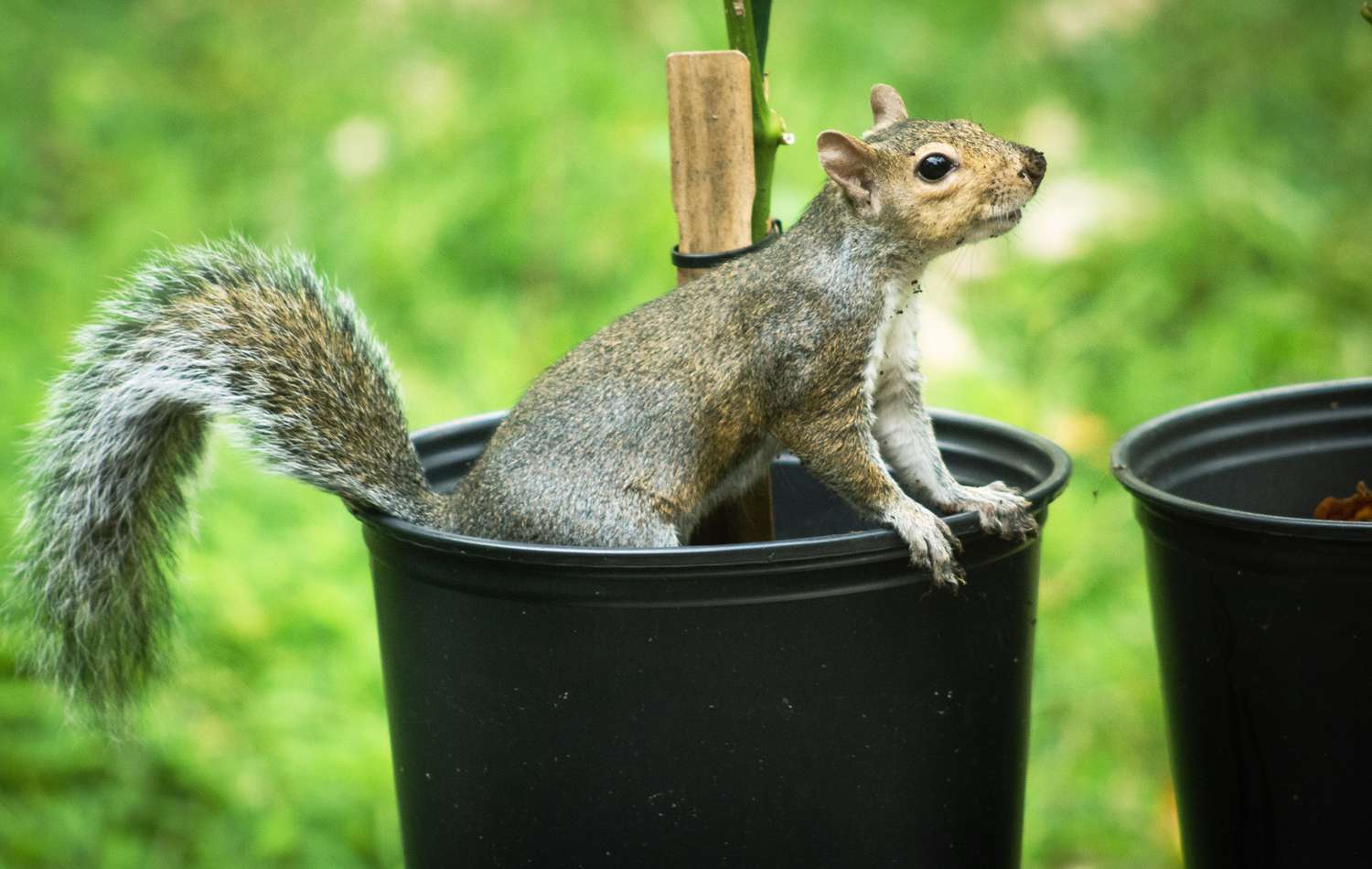
How to Keep Squirrels Out of Flower Pots: Protecting Your Plants from Unwanted Guests
Squirrels are a common sight in backyards, flitting through trees and burying nuts. They might chase each other playfully, but for gardeners, these adorable creatures can become a real headache.
While their antics can be entertaining, squirrels love to dig and forage. This can quickly turn your carefully cultivated flower beds into a disaster zone. Imagine uprooted plants, scattered seeds, and frustrated gardeners left picking up the pieces.
If you’ve found yourself battling these persistent pests, don’t despair! This comprehensive guide will equip you with the knowledge and tools to fight back.

Understanding Squirrels’ Behavior: Decoding Their Motives
To effectively deter squirrels from your flower pots, it’s essential to understand their motivations and behaviors. Squirrels are omnivorous creatures, consuming a diverse range of food sources, including nuts, seeds, fruits, and insects. Their keen sense of smell leads them to buried treasures, and the seeds and bulbs you’ve carefully planted in your flower pots can easily catch their attention as potential food caches.
Digging is a natural behavior for squirrels, as they bury food for later consumption. Unfortunately, your flower pots may appear as ideal locations for these hidden stashes. Squirrels are also territorial creatures, and your flower pots may be seen as part of their territory, prompting them to mark and defend them as their own.
Preventative Measures: Protecting Your Plants from the Start
Prevention is always the best approach when dealing with potential pests, and there are several effective measures you can take to discourage squirrels from approaching your flower pots in the first place.
-
Covering the Soil: Employ physical barriers to deter squirrels from digging in your flower pots. Chicken wire, hardware cloth, or plastic mesh placed over the soil surface can effectively block their access and protect your plants from disturbance.
-
Planting Thorny Plants: Surround your flower pots with plants that have thorns or prickly stems, such as roses, barberry bushes, or holly. These natural deterrents can discourage squirrels from approaching, as they don’t appreciate the discomfort caused by the thorns.
-
Using Strong-Smelling Substances: Squirrels have a sensitive sense of smell, and certain strong odors can repel them. Sprinkle cayenne pepper, garlic powder, or predator urine around your flower pots to create an unpleasant environment for squirrels. These substances emit scents that squirrels find offensive, making your flower pots less appealing.
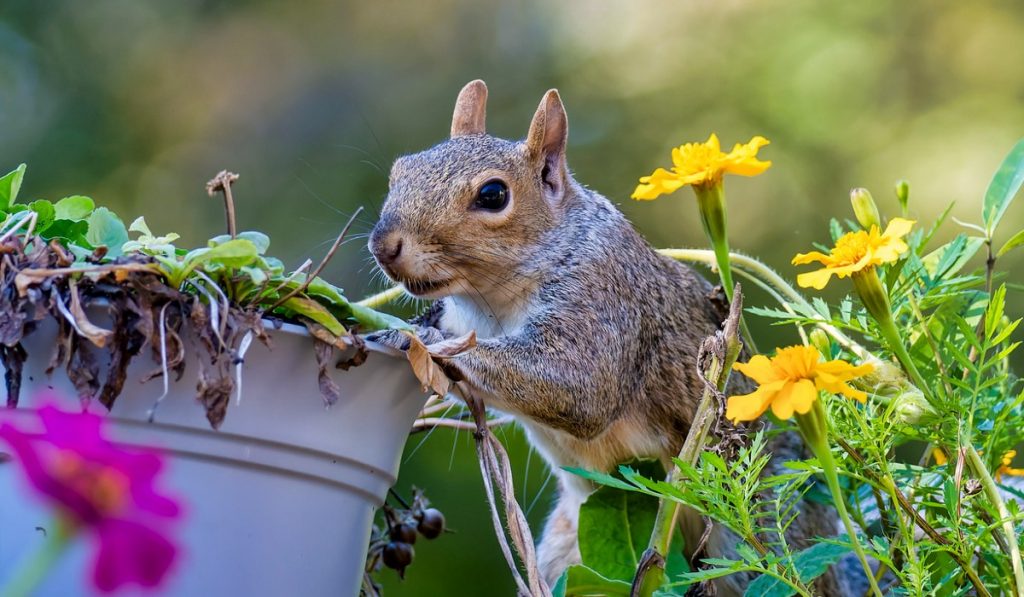
Repellent Solutions: Discouraging Squirrels When Prevention Isn’t Enough
In cases where preventative measures alone are not sufficient, repellents can provide an additional layer of protection for your flower pots. A variety of commercial repellents are available, typically in the form of sprays, granules, or bars. These products often contain ingredients that mimic predator scents or unpleasant tastes, effectively deterring squirrels from approaching.
-
Commercial Repellents: When selecting a commercial repellent, consider the type of plants you have in your flower pots, as some repellents may be harmful to certain plants. Follow the instructions on the product label carefully and apply the repellent regularly, especially after rain or irrigation, as these can wash away the repellent’s effectiveness.
-
Homemade Repellents: If you prefer a more natural approach, you can create your own repellents using ingredients like spicy peppers, garlic, or ammonia. Mix these substances with water and spray them around your flower pots. While homemade repellents may not be as potent as commercial ones, they can still provide a level of deterrence.
-
Motion-Activated Devices: For a more interactive approach, consider using motion-activated sprinklers or noisemakers. These devices emit a sudden burst of water or noise when they detect movement, startling squirrels and discouraging them from approaching your flower pots.
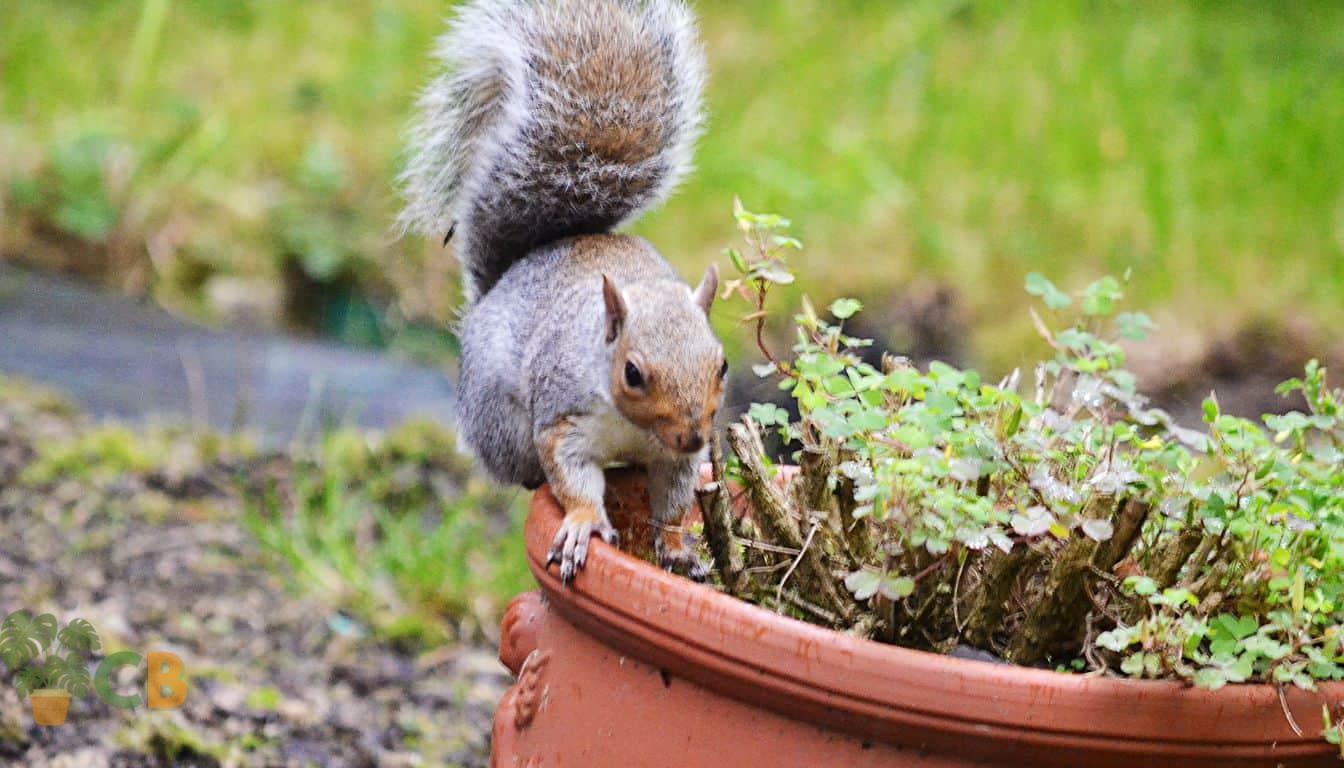
Additional Tips and Considerations: Enhancing Your Squirrel-Proofing Strategy
To further enhance your squirrel-proofing strategy, keep these additional tips in mind:
-
Timing is Crucial: Apply repellents regularly, especially after rain or irrigation, as they may wash away their effectiveness.
-
Rotate Repellents: Alternate between different repellents to prevent squirrels from becoming accustomed to any particular scent or taste. This keeps them guessing and reduces the likelihood of them developing a tolerance to any one repellent.
-
Address Underlying Issues: If squirrels are a persistent problem, consider addressing potential food sources in your yard, such as fallen nuts or unsecured bird feeders. Eliminating these readily available food sources can make your flower pots less attractive to squirrels.
Protecting Your Garden Sanctuary and Enjoying Your Blooms
and a bit of patience. By understanding squirrel behavior, implementing effective strategies, and adapting your approach as needed, you can create a garden sanctuary where your plants can thrive without the interference of these mischievous creatures. Remember, consistency and a proactive approach are key to deterring squirrels and protecting your precious blooms.
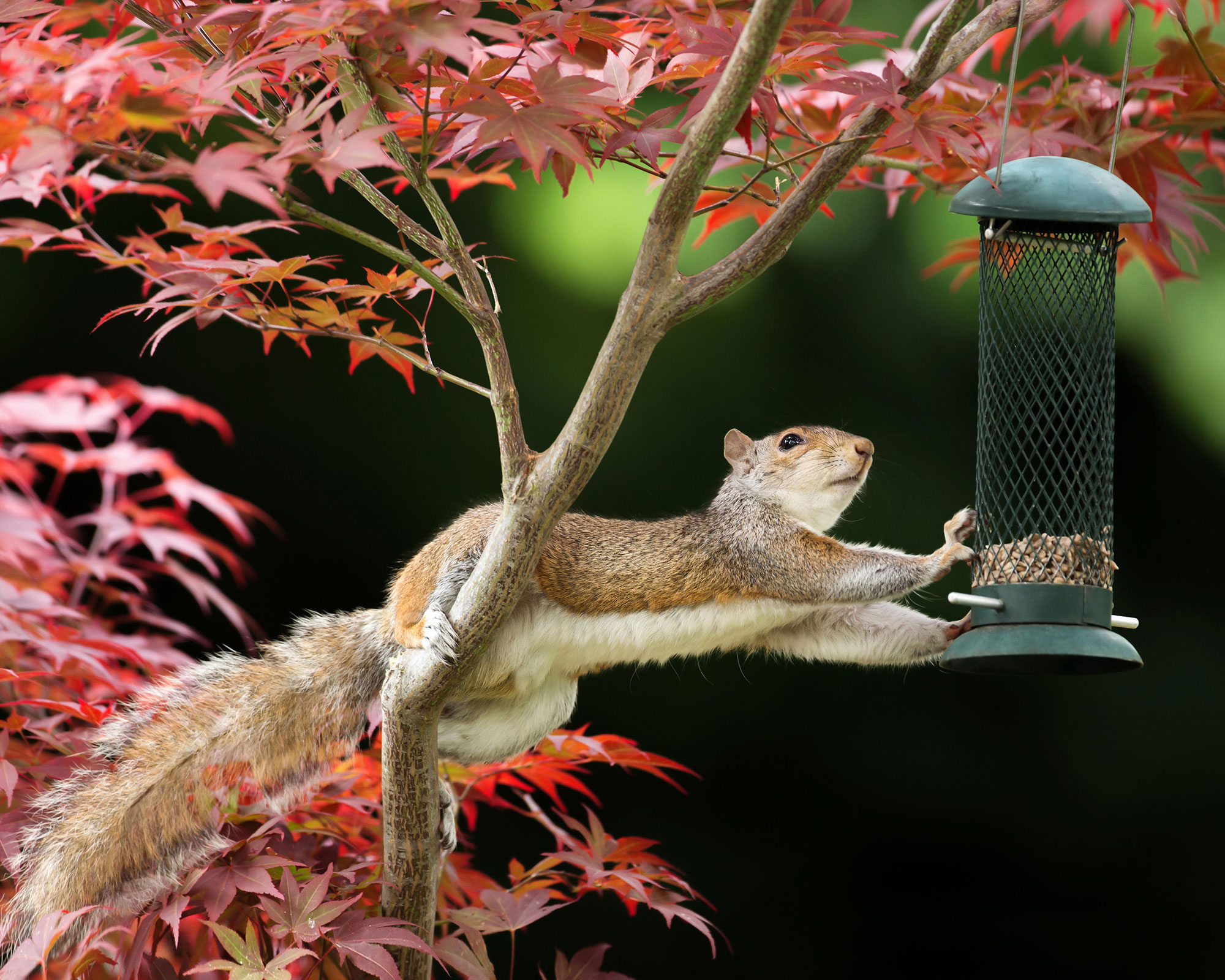
Celebrating Success and Embracing Harmony with Nature
Successfully keeping squirrels out of your flower pots allows you to reap the rewards of your gardening efforts. Witnessing your plants flourish, their vibrant blooms adding a touch of beauty to your outdoor space, can bring immense satisfaction.
However, it’s important to remember that squirrels are a vital part of the natural ecosystem. They play a role in seed dispersal and plant propagation. By employing humane and non-lethal deterrents, you can find a balance between protecting your plants and respecting the role these creatures play in the environment.
Sharing Your Knowledge and Inspiring Others
Gardening is a shared passion for many, and the challenges associated with deterring unwanted pests are common experiences. By sharing your knowledge and successful strategies with fellow gardeners, you can inspire others to create thriving gardens where both plants and wildlife can coexist peacefully.
Document your journey, the methods you used, and the results you achieved. Share your experiences online, in gardening forums, or with your local gardening community. By inspiring others, you can contribute to a collective knowledge base of effective and sustainable solutions for deterring squirrels and protecting gardens.
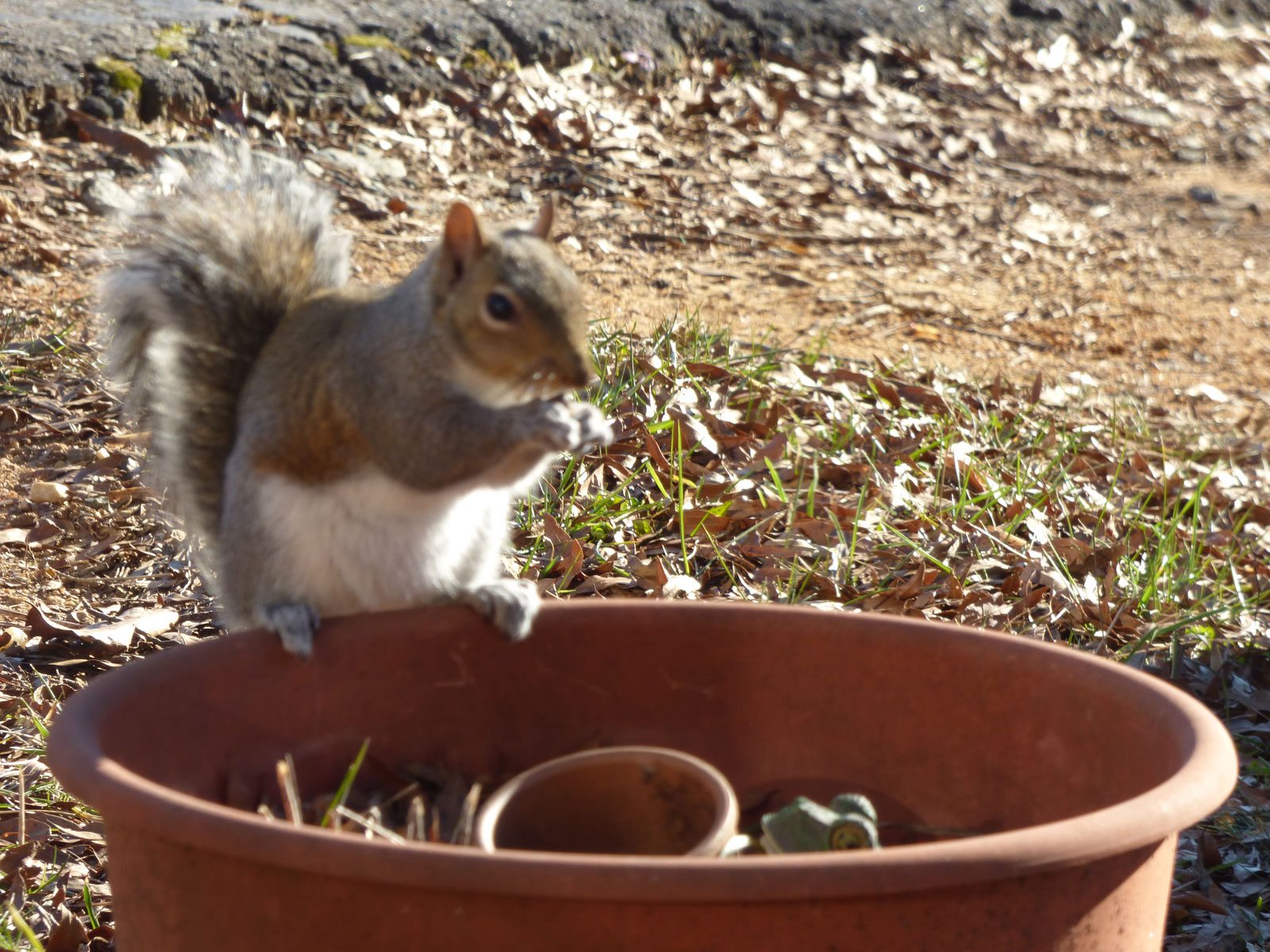

Hand-Painted Flower Pots: A Creative Guide to Crafting Personalized Planters
In the realm of home décor, where personal style and creativity reign supreme, hand-painted flower pots emerge as a delightful avenue for self-expression and artistic exploration. These humble vessels, once ordinary containers for greenery, can be transformed into vibrant masterpieces, seamlessly blending the natural beauty of plants with a touch of personalized flair. Whether you’re a seasoned artist seeking a new canvas or a curious beginner eager to unleash your inner creativity, this comprehensive guide will equip you with the knowledge and techniques to craft hand-painted flower pots that will brighten your space and bring joy to your gardening endeavors. 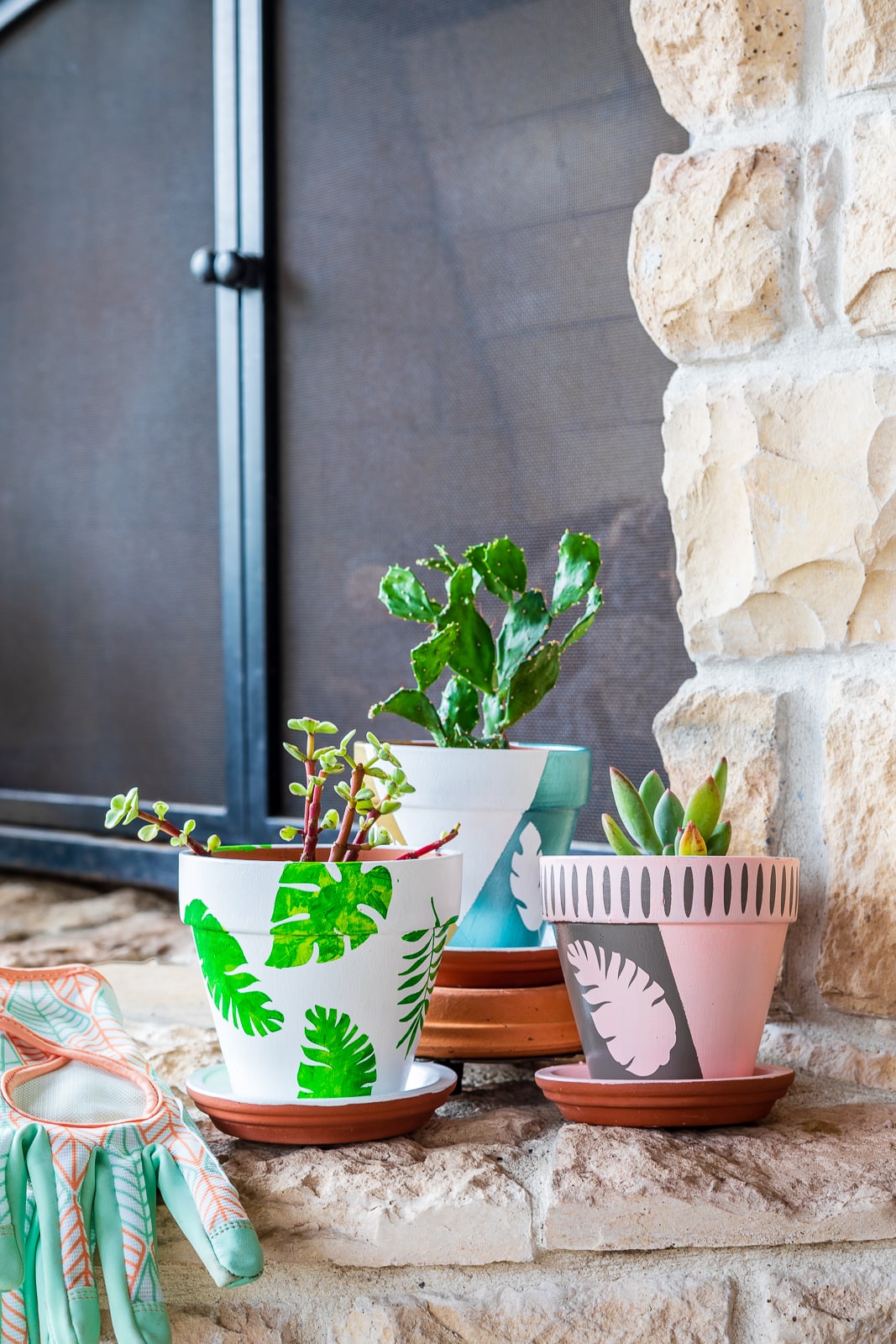
Embarking on a Creative Journey: Gathering Inspiration and Materials
Before embarking on your hand-painting adventure, it’s essential to gather inspiration and assemble the necessary materials to fuel your creative journey.
Seeking Inspiration from the World Around You:
-
Nature’s Palette: Immerse yourself in the wonders of nature, drawing inspiration from the vibrant hues of flowers, the intricate patterns of leaves, and the graceful forms of branches. Allow the natural world to ignite your imagination and guide your design choices.
-
Artistic Exploration: Venture into art galleries, museums, or online platforms to discover a diverse range of artistic styles and techniques. Observe how artists use color, composition, and texture to create visually captivating works of art.
-
Personal Preferences: Reflect on your personal style and the overall aesthetic of your living space. Consider the colors, patterns, and textures that harmonize with your décor, ensuring your hand-painted flower pots seamlessly blend into your home’s ambiance.
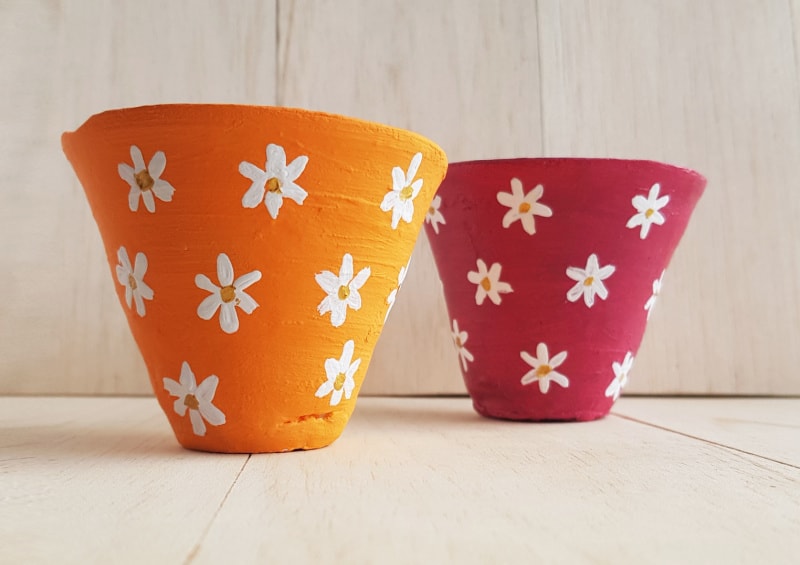
Gathering the Tools of the Trade:
-
Flower Pots as Your Canvas: Select flower pots that complement the size and style of your plants, considering the overall aesthetic you wish to achieve. Ensure the pots are clean, dry, and free of any debris that could hinder the painting process.
-
Acrylic Paints: A World of Colors: Choose acrylic paints that offer a vibrant range of colors, suitable for use on various surfaces. Consider purchasing a set of basic colors that you can mix and match to create your desired palette.
-
Paintbrushes: Your Artistic Instruments: Acquire a variety of paintbrushes in different sizes and shapes, enabling you to create delicate lines, broad strokes, and intricate details. Experiment with different brush types to discover the ones that best suit your artistic style.
-
Primer: Laying the Foundation: Opt for a high-quality primer to create a smooth and even base for your paint, enhancing color adhesion and vibrancy.
-
Sealant: Protecting Your Masterpiece: Choose a sealant specifically designed for acrylic paints to protect your artwork from moisture, fading, and scratches, ensuring its longevity.
-
Embellishments: Adding a Touch of Flair: Gather embellishments such as glitter, beads, or stencils to add texture, dimension, and a touch of personal flair to your designs.

Preparing the Stage for Creativity: Cleaning, Priming, and Sanding
With your inspiration and materials at hand, it’s time to prepare the flower pots for their artistic transformation.
Cleaning and Drying: Creating a Smooth Canvas:
- Thoroughly clean the flower pots using mild soap and water to remove any dirt, dust, or debris. Allow the pots to air dry completely before proceeding to the next step.
Priming: Enhancing Adhesion and Vibrancy:
- Apply a coat of primer to the entire surface of the flower pots, ensuring even coverage. Primer creates a base that allows the paint to adhere better and enhances the vibrancy of the colors.
Sanding (Optional): Achieving a Smooth Finish:
- For a smoother painting surface, lightly sand the primed pots using fine-grit sandpaper. This step is particularly beneficial for removing any imperfections or bumps from the primer layer.
Designing and Sketching: Bringing Your Vision to Life
With the flower pots prepared, it’s time to unleash your creativity and bring your design vision to life.
Brainstorming Ideas: Exploring Endless Possibilities:
-
Sketch out your design ideas on paper, experimenting with different patterns, colors, and compositions. Allow your imagination to run wild and explore various artistic styles.
-
Considering Plant Placement: Keep in mind the placement of your plants, ensuring the design complements the overall appearance of the potted arrangement. Consider the size and shape of the plants when selecting patterns and colors.
-
Transferring the Design (Optional): If desired, lightly transfer your sketched design onto the flower pot using a pencil or tracing paper. This step can provide a guide for painting, ensuring precise placement of elements.
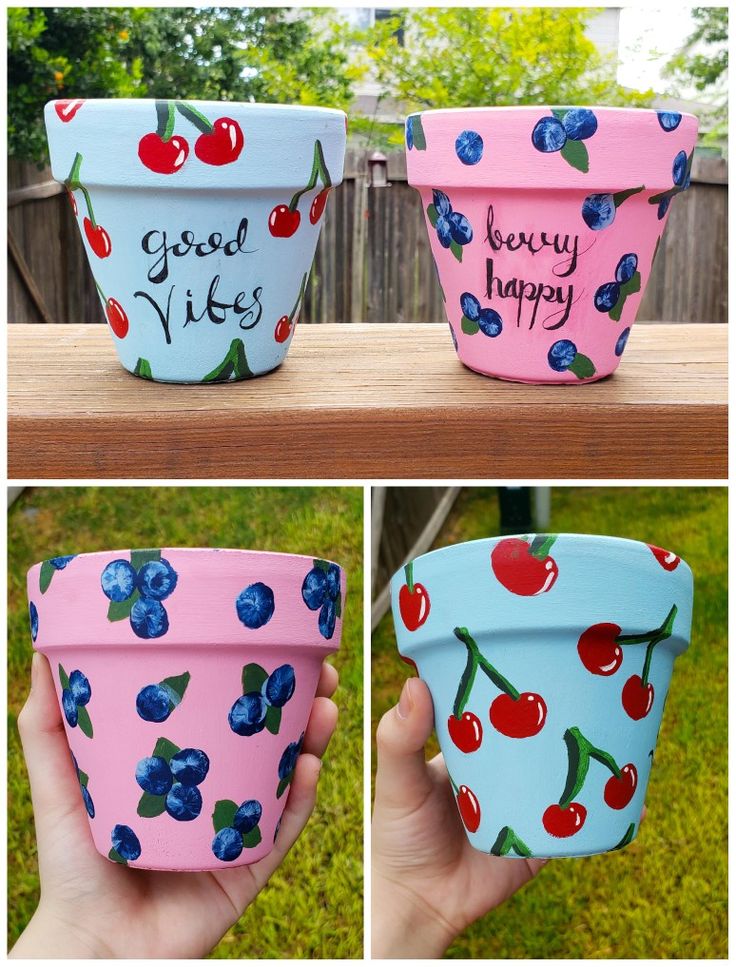
Applying Paint and Adding Details: Your Artistic Expression
With your design in mind, it’s time to transform your flower pots into vibrant masterpieces.
-
Choosing Base Colors: Select base colors that complement the overall color scheme of your space and the natural hues of the plants you intend to house in the pots. Experiment with color mixing to create custom shades that perfectly match your vision.
-
Painting Techniques: Employ acrylic paints and your chosen brushes to carefully paint your chosen patterns, shapes, or motifs onto the flower pots. Start with larger base colors and gradually add details and finer lines.
-
Layering and Blending: Don’t be afraid to layer colors and experiment with blending techniques to create depth and dimension in your artwork. Use a damp brush to soften harsh lines and create smooth transitions between colors.
-
Incorporating Details: Elevate your design by adding intricate details such as dots, lines, borders, or small geometric shapes. These details can frame your artwork and add visual interest.
Enhancing with Embellishments: Adding a Personal Touch
Once the base colors and details are complete, you can further personalize your hand-painted flower pots by incorporating various embellishments.
-
Glitter and Beads: For a touch of sparkle and texture, apply glitter or beads to specific areas of the design using glue or a brush-on adhesive. Experiment with different glitter colors and bead sizes to create a unique effect.
-
Stencils for Precise Designs: If you desire precise patterns or intricate designs, stencils can be a valuable tool. Choose stencils with patterns that complement your overall design and carefully apply paint through the stencil cutouts.
-
Textural Techniques: Explore various techniques like stippling (using a short, tapping motion with the brush) or sponging (applying paint with a sponge) to introduce different textures and visual effects to your artwork.
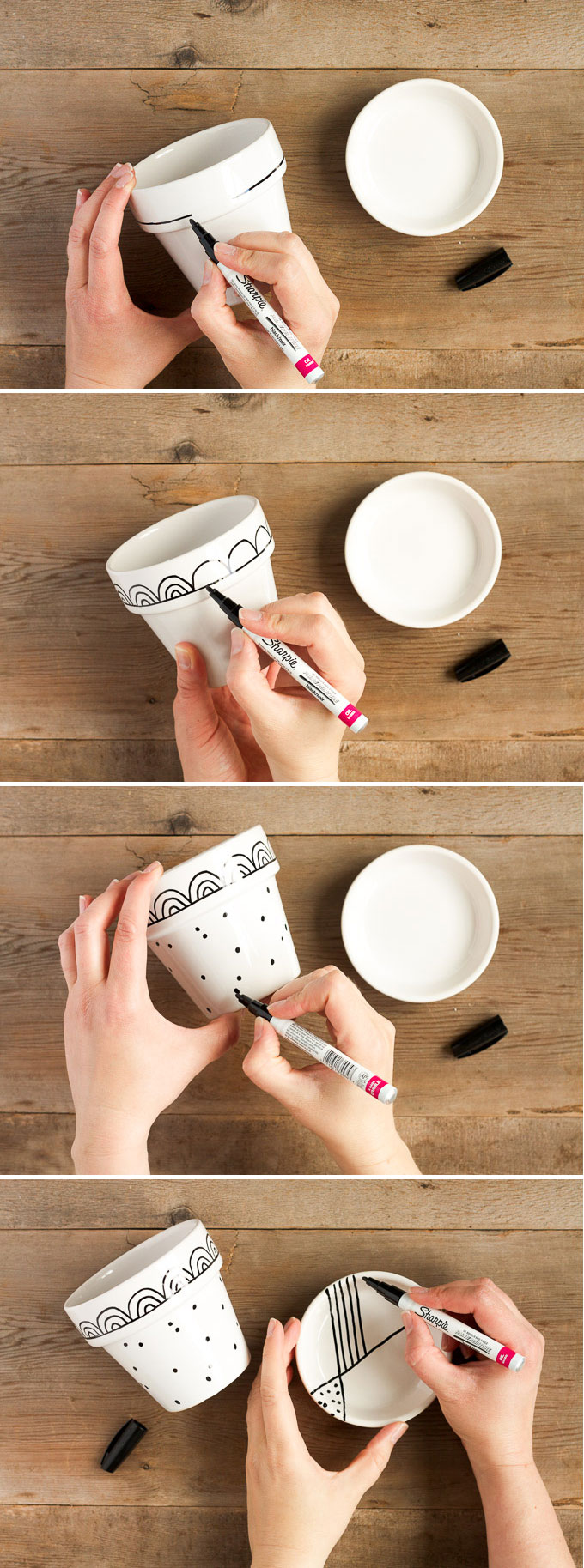
Sealing and Protecting Your Artwork: Ensuring Longevity
After completing your artistic masterpiece, it’s crucial to protect your creation from the elements to ensure its longevity.
-
Applying Sealant: Once the paint is completely dry, apply a coat of sealant specifically designed for acrylic paints. This sealant will protect the artwork from moisture, fading, and scratches, preserving its vibrancy for years to come.
-
Additional Coats for Durability: Consider applying multiple coats of sealant, especially if your flower pots will be placed outdoors or exposed to direct sunlight. Each additional coat enhances the protective barrier.
-
Allowing Drying Time: Allow the sealant to dry completely according to the manufacturer’s instructions before using or planting anything in the pots.
Displaying Your Hand-Painted Creations: Showcasing Your Work
With your hand-painted flower pots complete and protected, it’s time to find the perfect spot to showcase your artistic achievements.
-
Choosing the Right Location: Select a location in your home that receives ample natural light, allowing the vibrant colors and intricate details of your artwork to shine. Consider placing your creations near windows, on shelves, or as table centerpieces.
-
Grouping or Arranging Individually: Decide whether to group your hand-painted flower pots together to create a visually impactful display or arrange them individually as focal points throughout your living space.
-
Complementing Your Décor: Harmonize your hand-painted flower pots with other décor elements in your space, such as throw pillows, curtains, or artwork. Consider the overall color scheme and style of your décor when choosing placement and grouping arrangements.
Additional Tips and Inspiration: Fueling Your Creativity
As you embark on your hand-painted flower pot adventure, here are some additional tips and sources of inspiration to keep your creative juices flowing:
-
Practice Makes Perfect: Before diving into your final flower pots, practice painting on scrap materials like cardboard or old plates. This allows you to refine your technique, experiment with colors, and gain confidence before tackling the real deal.
-
Nature’s Inspiration: Draw inspiration from the natural world around you. Observe the vibrant hues of flowers, the intricate patterns of leaves, or the graceful forms of branches and incorporate these elements into your designs.
-
Embrace Imperfections: Remember, hand-painted art thrives on its uniqueness. Embrace the slight imperfections that may arise during the process, as they add character and charm to your creations.
Conclusion: A World of Creative Expression Awaits
Hand-painting flower pots is a rewarding and enriching endeavor that allows you to personalize your living space, express your artistic flair, and nurture your plants in a unique and stylish way. By following these simple steps, gathering inspiration, and experimenting with different techniques, you can transform ordinary flower pots into vibrant masterpieces that bring joy to your home and elevate your gardening experience. Remember, the beauty of hand-painted art lies in its individuality and the personal touch it brings to your surroundings. So, unleash your creativity, embrace the process, and let your imagination transform your flower pots into works of art that reflect your unique style.

Bamboo Garden Stakes: Embracing the Versatility and Sustainability of Nature
 I. Introduction: Nature’s Supportive Touch
I. Introduction: Nature’s Supportive Touch
A. Beyond aesthetics: Bamboo garden stakes are more than just garden ornaments. Crafted from the resilient shoots of bamboo plants, these natural wonders provide sturdy and flexible support for your precious flora.
B. Sustainable Support System: Bamboo stakes seamlessly integrate with eco-conscious gardening practices. Unlike traditional materials, they offer plant support while minimizing environmental impact.

II. Unveiling Versatility: A Stake for Every Plant
A. Universal Champions: From delicate flowers to sprawling vines, bamboo stakes come in various sizes, offering the perfect fit for a wide range of plants, including vegetables and even small trees.
B. Strength Meets Flexibility: Surpassing traditional wood and metal stakes, bamboo boasts exceptional strength, flexibility, and impressive resistance to rot, making it the ideal choice for diverse plant support needs.
III. The Green Choice: Embracing Sustainability
A. Nature’s Gift: Unlike non-biodegradable materials, bamboo stakes decompose naturally, minimizing environmental impact and aligning perfectly with organic gardening practices.
B. A Greener Tomorrow: By choosing bamboo, you’re actively contributing to sustainable gardening. It’s a conscious decision that promotes a greener approach to landscaping, fostering a healthy future for our planet.

IV. Selecting and Installing: A Recipe for Success
A. Finding the Perfect Fit: Matching the stake size and thickness to the specific plant’s height and weight distribution ensures optimal support, allowing your plants to thrive.
B. Secure Support: Proper installation is key. Securely anchoring the stakes and adjusting ties or clips prevents damage to plants and fosters healthy, flourishing growth.
V. Beyond Support: A Touch of Natural Elegance
A. Aesthetic Appeal: Bamboo stakes go beyond functionality. Their natural beauty provides visually appealing support, enhancing your garden’s overall charm and creating a harmonious connection with nature.
B. Designing with Nature: Incorporate bamboo stakes creatively into your garden design. They add visual interest and define areas or pathways, creating a cohesive and aesthetically pleasing landscape.
VI. Ensuring Longevity: Caring for Your Stakes
A. Extending the Lifespan: Simple care practices, like periodic cleaning and protection from excessive moisture, go a long way in extending the lifespan of your bamboo stakes.
B. Maintaining a Healthy Garden: Regularly inspect your stakes. Timely replacement of worn-out or damaged bamboo ensures continued support for your plants and maintains a healthy garden environment.

VII. A Sustainable Champion: Standing Out from the Crowd
A. Beyond Traditional Options: Bamboo stakes offer distinct advantages compared to traditional wood or metal alternatives. Their sustainability and superior resistance to weathering make them the clear choice for eco-conscious gardeners.
B. Weighing the Options: While each material has its merits, bamboo stakes excel in specific areas. Their eco-friendly characteristics and impressive durability make them a standout choice for sustainable gardening.
VIII. Unleashing Creativity: Beyond the Ordinary Stake
A. DIY Delights: The possibilities are endless! Use bamboo stakes for creative and functional garden projects. Build trellises, craft charming fences, or even sculpt unique garden features.
B. Unconventional Applications: Bamboo’s versatility extends beyond traditional uses. Let your imagination run wild! Explore unconventional roles for your bamboo garden stakes, fostering artistic expressions and innovative landscaping solutions.
IX. A Sustainable Oasis Awaits
A. A Multifaceted Wonder: Bamboo garden stakes offer a unique combination of functionality and sustainability. They support plant growth while promoting innovative and eco-friendly gardening practices.
B. Inspiring Innovation: More than just a support system, bamboo stakes serve as a symbol of sustainable practices. By embracing bamboo, you’re not only nurturing your garden but also inspiring inventive and environmentally responsible approaches to gardening. Let your creativity flourish alongside your plants, and transform your outdoor space into a thriving, sustainable oasis.
X. Safety Considerations: A Priority for Plant and People
A. Smooth Choice: Opt for smooth bamboo stakes to avoid splinters. This ensures the safety of both you and your loved ones while tending to your garden.
B. Secure Installations: Improperly placed stakes can pose a tripping hazard. Ensure secure installation and avoid placing stakes in high-traffic areas to maintain a safe and enjoyable outdoor space.
XI. Sourcing Responsibly: Ensuring Sustainability
A. Know Your Source: Look for bamboo garden stakes from responsible vendors who prioritize sustainable harvesting practices. This ensures the continued health of bamboo forests and minimizes environmental impact.
B. Supporting Sustainable Businesses: By choosing ethically sourced bamboo stakes, you’re actively supporting businesses that prioritize environmental responsibility and contribute to a more sustainable future.
XII. Bamboo Beyond the Stakes: Expanding the Theme
A. Cohesive Harmony: Extend the bamboo theme by incorporating other bamboo elements into your garden design. Explore bamboo fencing, water features, or furniture to create a unified and visually appealing aesthetic.
B. A Symphony of Sustainability: Bamboo planters for your flowers and greenery perfectly complement bamboo stakes. This creates a cohesive and sustainable outdoor living space, showcasing your appreciation for nature’s beauty.
XIII. Cost-Effectiveness: A Budget-Friendly Choice
A. Value for Money: Bamboo garden stakes offer exceptional value for money. Their durability and reusability make them a cost-effective option for supporting your plants in the long run.
B. Sustainable Savings: By embracing a sustainable material like bamboo, you’re not just helping the environment; you’re also making a smart financial decision.
XV. Winter Care: Protecting Your Bamboo Stakes
A. Seasonal Slumber: As winter approaches, consider storing your bamboo stakes in a cool, dry location to minimize exposure to harsh weather elements that can accelerate wear and tear.
B. Preparing for Spring: Before the first signs of spring, inspect your stored stakes and provide any necessary cleaning or light maintenance to ensure they’re ready for another season of supporting your plants.
XVI. Educational Opportunities: Learning Through Nature
A. Engaging Young Minds: Bamboo garden stakes can be a springboard for educational activities. Use them to create miniature landscapes or plant identification markers, fostering a love for nature in young minds.
B. Family Fun: Get the whole family involved in decorating bamboo stakes with paint, ribbons, or natural materials. This fosters creativity, teamwork, and a deeper appreciation for the natural world.
XVII. A Final Note: A Legacy of Sustainability
A. Beyond Your Garden: The positive impact of bamboo garden stakes extends beyond your personal space. By choosing bamboo, you’re contributing to a larger movement towards sustainable gardening practices.
B. Inspiring Change: Let your eco-friendly garden serve as an inspiration to others. Share your knowledge and showcase the beauty of bamboo, encouraging a shift towards more sustainable landscaping solutions in your community.
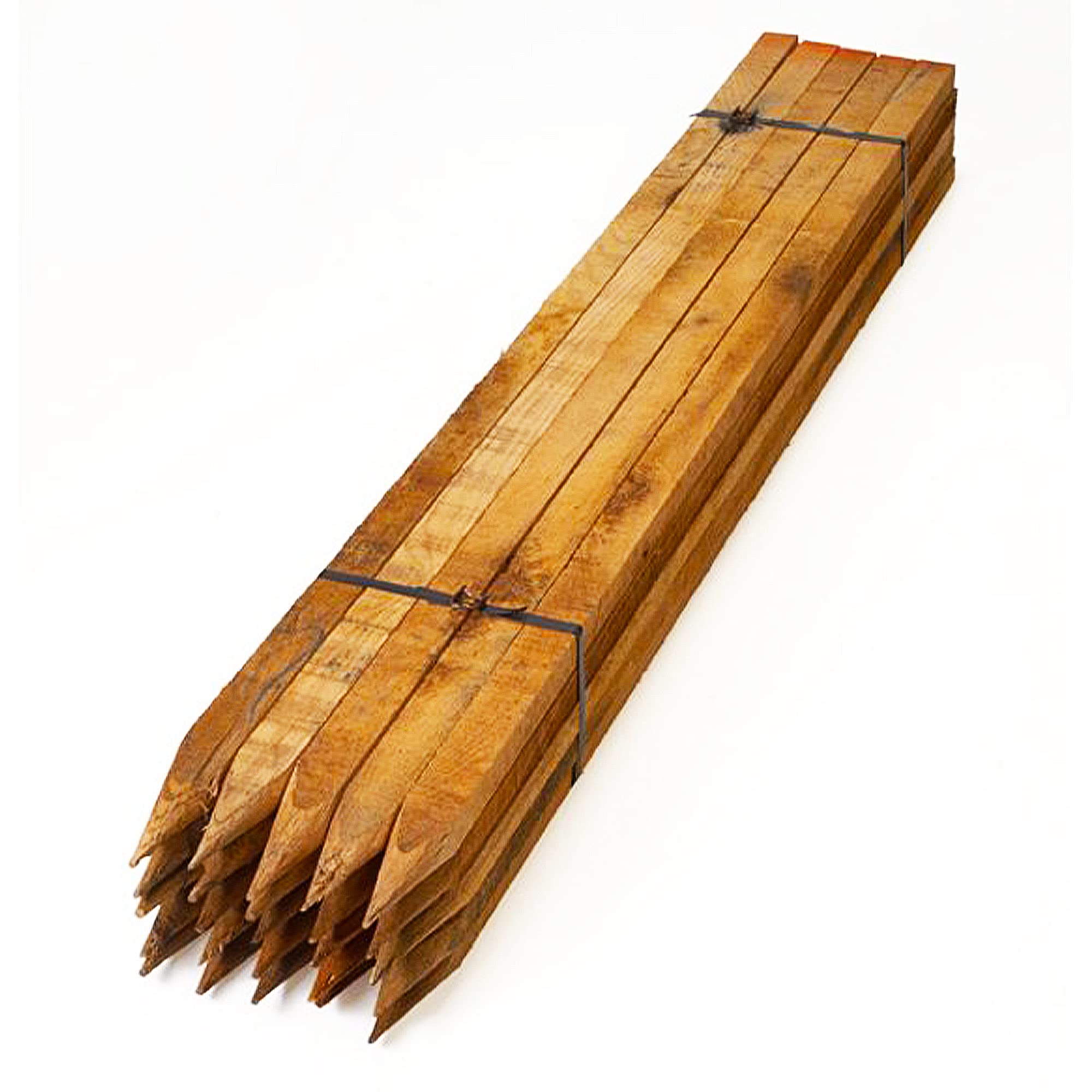
Wooden Garden Stakes: Embracing the Enduring Charm of Nature
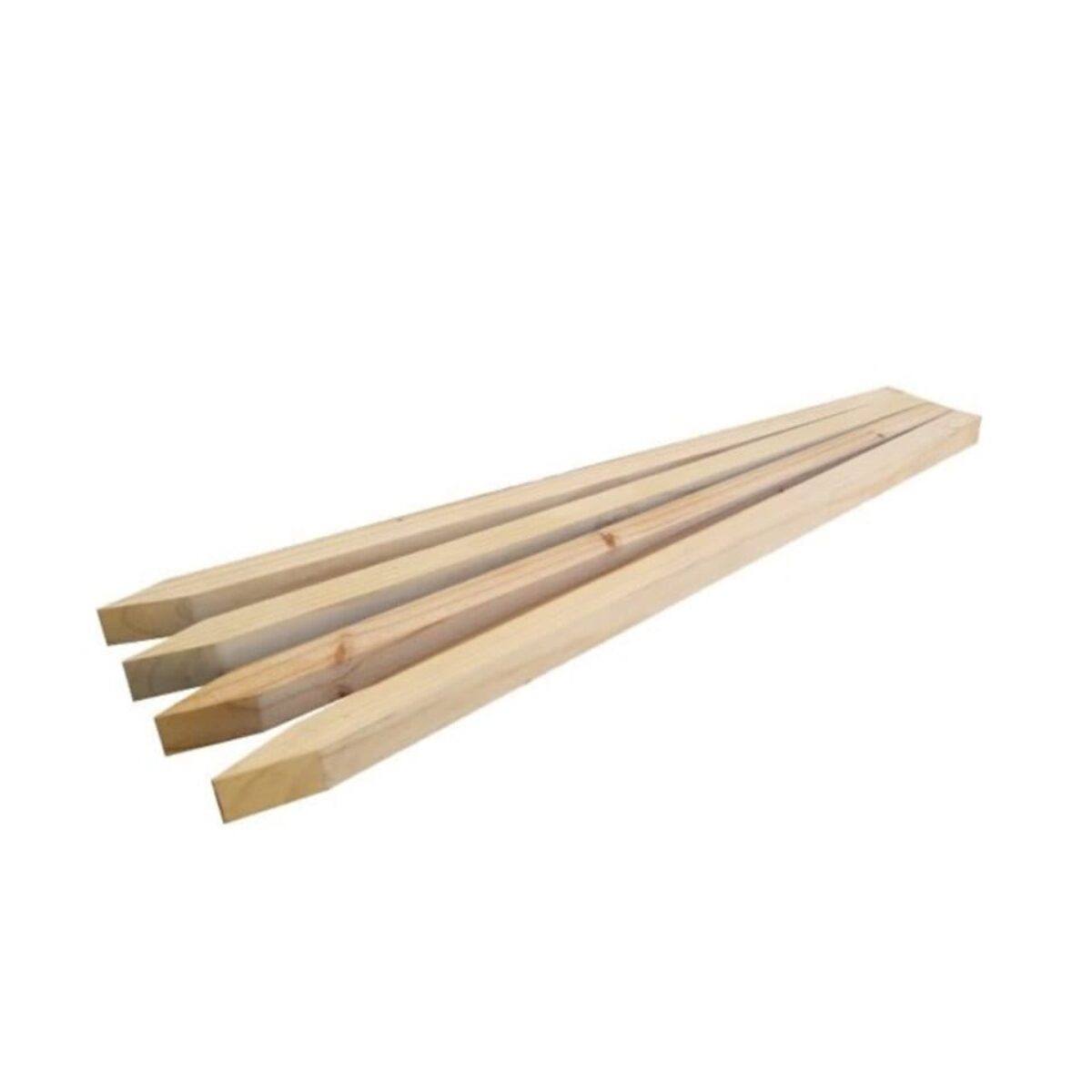 The world of outdoor décor transcends mere functionality. It’s about weaving stories, injecting personality, and bringing nature’s magic closer to home. In this realm, wooden garden stakes stand out as a testament to rustic charm and enduring appeal. Crafted from the heart of forests, these accents add warmth, character, and timeless elegance to any outdoor space.
The world of outdoor décor transcends mere functionality. It’s about weaving stories, injecting personality, and bringing nature’s magic closer to home. In this realm, wooden garden stakes stand out as a testament to rustic charm and enduring appeal. Crafted from the heart of forests, these accents add warmth, character, and timeless elegance to any outdoor space.
The Enchantment of Wood
The allure of wooden garden stakes lies in their ability to evoke a sense of rustic charm and a harmonious connection with the outdoors. Often hand-carved or crafted from weathered wood, these earthy accents possess a unique character that whispers of nature’s enduring power. Their rustic appeal adds warmth and authenticity, transforming ordinary gardens into havens of tranquility and natural beauty. Whether it’s the intricate details of a hand-carved animal, the weathered patina of a vintage windmill, or the simple elegance of a silhouette stake, wooden garden stakes remind us of the simple pleasures and timeless beauty nature offers.
A World of Styles for Every Garden
The world of wooden garden stakes is a vast and diverse landscape catering to every taste and preference. From whimsical animal figures and enchanting fairy tale characters to elegant floral designs and rustic nature-inspired motifs, there’s a wooden garden stake to complement any garden’s unique personality. Embrace the warmth of weathered cedar, the sleek lines of modern oak, or the timeworn beauty of reclaimed pine – the variety guarantees you’ll find the perfect pieces to bring your garden to life.

Themes to Inspire Your Imagination
-
Whimsical and Fairytale Themes: Unleash your imagination with wooden garden stakes featuring fairies, gnomes, playful animals, and other enchanting characters. These playful accents add a touch of magic and wonder to gardens, transforming them into whimsical realms where anything is possible.
-
Floral and Nature-Inspired Themes: Embrace nature’s beauty with wooden garden stakes showcasing flowers, leaves, butterflies, and other natural elements. These elegant designs bring a touch of sophistication and natural charm, creating a harmonious blend of indoor and outdoor living.
-
Seasonal and Holiday Themes: Celebrate changing seasons and special occasions with wooden garden stakes featuring snowflakes, pumpkins, Easter bunnies, and more. These festive motifs add a touch of cheer and mark the passage of time, creating lasting memories throughout the year.

Strategic Placement for Maximum Impact
The placement and arrangement of wooden garden stakes play a crucial role in maximizing their visual impact and enhancing the overall aesthetic of your garden. Consider grouping stakes by theme, color, or height to create cohesive arrangements that draw the eye and add a sense of balance. Strategically place stakes to accentuate garden features like flower beds, pathways, and entryways. Utilize them to define borders, delineate pathways, and add visual interest to walkways, creating a sense of direction and inviting exploration.
Craft Your Own Personal Touches
For those with a creative spark, DIY wooden garden stakes offer a chance to personalize their outdoor décor and express their unique style. Unleash your creativity through wood carving, wood burning, or painting wooden stakes, creating one-of-a-kind accents that reflect your personality. Engage in family craft activities – paint wooden spoons, decorate rocks, or make paper flowers. These DIY endeavors not only enhance your garden’s beauty but also provide a fun and educational experience for the whole family.
Ensuring Long-Lasting Beauty
To ensure the long-lasting beauty and durability of your wooden garden stakes, proper care and maintenance are essential. Shield them from harsh weather elements like sunlight, rain, and wind by applying protective coatings or sealing materials. During off-seasons, consider storing them for optimal preservation. Regular cleaning and maintenance also play a vital role. Use gentle cleaning methods appropriate for the type of wood, such as wiping them down with a damp cloth and mild soap solution. Remove dirt, debris, and discoloration promptly to prevent them from setting in and compromising the wood’s integrity.
Safety First for Enjoyable Use
Safety should always be a top priority when choosing and using wooden garden stakes, especially if you have children or pets who frequent your outdoor space. Opt for stakes made from non-toxic and durable wood, free from splinters or sharp edges that could cause injury. Avoid stakes with small parts that might pose a choking hazard to young children or curious pets. When placing stakes, ensure they are securely anchored in the ground to prevent tripping hazards. Regularly inspect your wooden garden stakes for any signs of damage or rot, and replace them if necessary to maintain a safe and enjoyable outdoor environment.

Conclusion
Wooden garden stakes are a delightful and versatile addition to any outdoor space. With their timeless charm, natural beauty, and endless design possibilities, they offer a simple yet effective way to inject personality, warmth, and visual interest into your garden. Whether you seek to create a whimsical wonderland, a tranquil nature retreat, or a festive seasonal display, wooden garden stakes provide the perfect finishing touches to bring your vision to life.
Beyond the Stake: Additional Touches
Wooden garden stakes can be the foundation for a captivating outdoor experience, but there are additional ways to weave them into a cohesive theme. Here are some ideas to inspire you:
-
Create miniature landscapes: Group stakes featuring animals, houses, and natural elements to create miniature scenes within your garden. This is a fantastic way to engage children’s imaginations and bring storybook scenes to life.
-
Incorporate lighting: Combine wooden garden stakes with solar-powered lights for a magical touch after dark. Place them strategically near pathways, flower beds, or water features to create a warm and inviting ambiance.
-
Bird feeders and houses: Wooden garden stakes can be functional too! Look for bird feeders or houses crafted from wood to seamlessly blend with your stake collection and attract feathered friends to your garden.
-
Wind chimes and spinners: Add a touch of whimsy and musicality with wind chimes or spinners featuring wooden elements. The gentle sounds and movement will add another layer of sensory experience to your outdoor space.

A Final Note: A Sustainable Choice
Wooden garden stakes can also be an eco-conscious choice for your garden décor. Opt for stakes made from sustainably sourced wood and ensure proper disposal of old or broken stakes. By making informed choices, you can contribute to environmental well-being while beautifying your outdoor haven.
Wooden garden stakes can transform your outdoor space into a captivating haven that reflects your unique personality and appreciation for nature’s beauty. So, explore the diverse options available, unleash your creativity. And embark on a journey to create a garden that sparks joy and inspires wonder.
